 Among the most abundant and aesthetically varied fossils are the ammonites. These shelled marine mollusks are related to living cephalopods such as octopus, squid, and cuttlefish. With a fossil record that spans the globe and the Devonian through Cretaceous periods (408 - 66 million years ago), ammonites were very successful animals, evolving into a range of sizes, habitats, and shell morphologies. Their long evolutionary history ended 66 million years ago, in the same mass extinction that eliminated non-avian dinosaurs and many other animals and plants.Ammonites are very useful for determining the age of the rocks in which they occur, with different shell morphologies occurring only in certain slices of time. For example, in previous posts, I have discussed Cretaceous dinosaurs from New Mexico. Although we don't yet know the exact age of the Menefee Formation, the rock layer in which the dinosaur fossils occur, we do know that they must be older than 78.5 million years because the rocks right above the Menefee contain an ammonite called Baculites perplexus, which is tied to an age of about 78.5 million years old.In today's photo are four fossil ammonite shells, each representing a different species. These shells were donated to the Western Science Center and come from Tarrant County, Texas. Dating to around 105 million years ago, these ammonites lived in the early history of a shallow saltwater sea that covered much of the interior of North America during the Late Cretaceous. You can see these four ammonites and the fossils of many other prehistoric sea creatures in the Western Science Center's new temporary exhibit, "Life in the Ancient Seas".
Among the most abundant and aesthetically varied fossils are the ammonites. These shelled marine mollusks are related to living cephalopods such as octopus, squid, and cuttlefish. With a fossil record that spans the globe and the Devonian through Cretaceous periods (408 - 66 million years ago), ammonites were very successful animals, evolving into a range of sizes, habitats, and shell morphologies. Their long evolutionary history ended 66 million years ago, in the same mass extinction that eliminated non-avian dinosaurs and many other animals and plants.Ammonites are very useful for determining the age of the rocks in which they occur, with different shell morphologies occurring only in certain slices of time. For example, in previous posts, I have discussed Cretaceous dinosaurs from New Mexico. Although we don't yet know the exact age of the Menefee Formation, the rock layer in which the dinosaur fossils occur, we do know that they must be older than 78.5 million years because the rocks right above the Menefee contain an ammonite called Baculites perplexus, which is tied to an age of about 78.5 million years old.In today's photo are four fossil ammonite shells, each representing a different species. These shells were donated to the Western Science Center and come from Tarrant County, Texas. Dating to around 105 million years ago, these ammonites lived in the early history of a shallow saltwater sea that covered much of the interior of North America during the Late Cretaceous. You can see these four ammonites and the fossils of many other prehistoric sea creatures in the Western Science Center's new temporary exhibit, "Life in the Ancient Seas".
Fossil Friday - Foerestephyllum
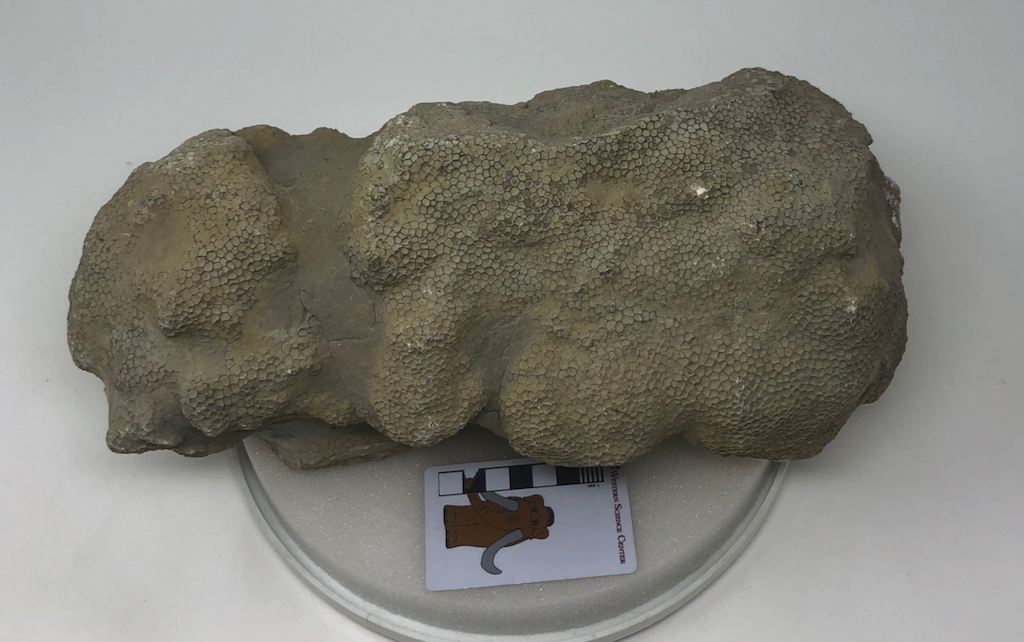 Corals are such an iconic part of the modern ocean, it's easy to overlook the fact that they didn't become widespread until the Ordovician Period, 4 billion years after the Earth formed and some 30 million years after the Cambrian Explosion.The coral shown above is Foerstephyllum, and example of a tabulate coral. The Tabulata are one of the two common types of fossil corals in the Paleozoic Era, along with the Rugosa. Of course, an important reason these groups are common as fossils is because they made large calcite structures that preserve very well. At least in the modern ocean, there are many soft-bodied corals that would be much less likely to fossilize, and that may have been the case in the past as well.This Foerstephyllum head comes from the Drakes Formation near Bardstown, Kentucky. There is a layer within this unit that is made mostly of large coral heads:
Corals are such an iconic part of the modern ocean, it's easy to overlook the fact that they didn't become widespread until the Ordovician Period, 4 billion years after the Earth formed and some 30 million years after the Cambrian Explosion.The coral shown above is Foerstephyllum, and example of a tabulate coral. The Tabulata are one of the two common types of fossil corals in the Paleozoic Era, along with the Rugosa. Of course, an important reason these groups are common as fossils is because they made large calcite structures that preserve very well. At least in the modern ocean, there are many soft-bodied corals that would be much less likely to fossilize, and that may have been the case in the past as well.This Foerstephyllum head comes from the Drakes Formation near Bardstown, Kentucky. There is a layer within this unit that is made mostly of large coral heads: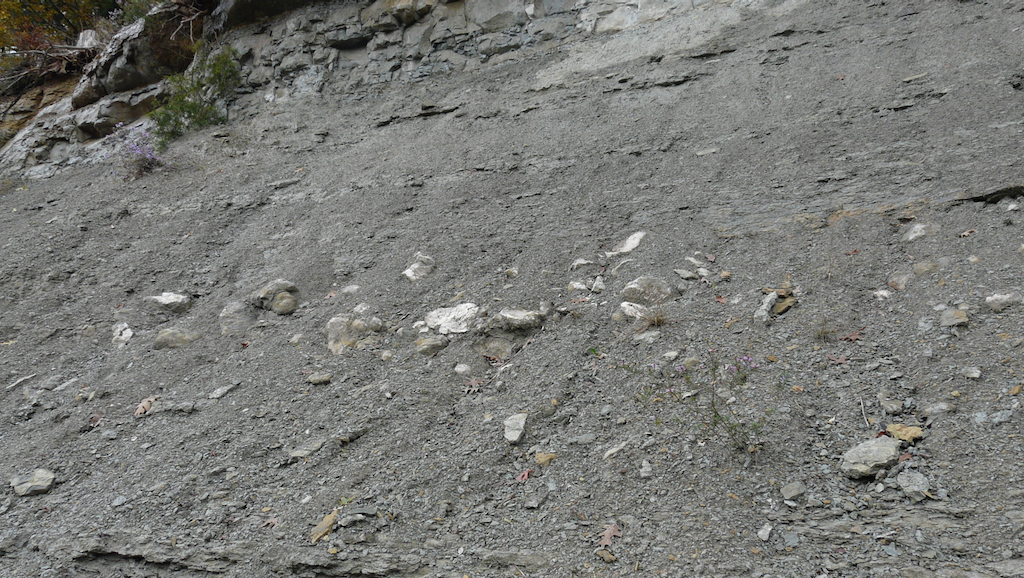 This bed is close to the top of the Ordovician; in fact, the massive rocks visible in the upper left corner are Silurian, although I think there is an unconformity between them.Tabulate corals remained as significant reef-builders up to the end of the Paleozoic Era. They went extinct, along with the rugose corals and about 90% or more of all marine species, in the devastating mass extinction at the end of the Permian Period.This specimen of Foerstephyllum is currently on display at the Western Science Center in the "Life in the Ancient Seas" exhibit, and a 3D model is available for viewing and download on SketchFab at https://skfb.ly/6NtRI.
This bed is close to the top of the Ordovician; in fact, the massive rocks visible in the upper left corner are Silurian, although I think there is an unconformity between them.Tabulate corals remained as significant reef-builders up to the end of the Paleozoic Era. They went extinct, along with the rugose corals and about 90% or more of all marine species, in the devastating mass extinction at the end of the Permian Period.This specimen of Foerstephyllum is currently on display at the Western Science Center in the "Life in the Ancient Seas" exhibit, and a 3D model is available for viewing and download on SketchFab at https://skfb.ly/6NtRI.
Fossil Friday - bourbon and geology
2011-02-20a
2011-02-20b
2011-02-20c
2011-02-20d
2011-02-20e
2011-02-20f
2011-02-20g
2011-02-20h
2011-02-20i
In a few weeks we'll be opening our new exhibit at WSC, "Life in the Ancient Seas", which will include a fair number of specimens from Ordovician rocks in the midwest. In recognition of that event, I'm reposting this post, originally published on my old blog "Updates from the Paleontology Lab" in 2011.A signature product of the southeastern United States, and one with which my family has had a generations-long relationship (at least as consumers), is bourbon whiskey. Bourbon is produced through a rather complex process involving the fermentation of corn and grain, which is then double- or triple-distilled and finally aged in charred white oak barrels; the general guidelines defining bourbon are actually formalized in U. S. law. Approximately 90% of all the bourbon produced in the U.S. comes from the Bluegrass region of northern Kentucky, so Brett and I spent the weekend there with our friends Andy and Shannon exploring the Bourbon Trail, visiting six distilleries in two days (Makers Mark Distillery’s aging warehouse shown above). But what makes this region so good for producing bourbon?It’s all in the water. Bourbon production is a water-intensive process, with water figuring heavily in every stage of production (Fryar, 2009). A steady supply of low-temperature water is important for the distilling process, and in early (pre-refrigeration) days that meant natural springs. It helps the fermentation process if the water has a somewhat high pH, as bacteria involved in fermentation respond well to these conditions. A high iron content in the water is bad, as it adversely affects both color and taste. But this simply moves our question back another step; why does northern Kentucky have water with these characteristics?To answer that, we have to go back to the Ordovician. The Inner Bluegrass region is underlain mainly by lower and middle Ordovician rocks, while the Outer Bluegrass region is mostly underlain by late Ordovician and Silurian rocks (as shown on this Google Earth/USGS map overlay):During the Ordovician Kentucky sat in the tropics, and this area was part of a vast carbonate platform covered by a shallow inland sea. The evidence can be seen in every roadcut in the area (such as the one shown above, south of Lexington), in the form of huge numbers of marine invertebrate fossils. The fauna is dominated by brachiopods and bryozoans, with large numbers or rugose and tabulate corals, crinoids, trilobites, mollusks, and a variety of less common critters:The rocks containing these fossils are almost entirely limestone, mostly made of fragments of the shells. This limestone is very porous, and like all limestones is composed primarily of carbonate minerals, especially calcite (CaCO3). Calcite is quite soluble, especially in acidic water, and limestone areas are often riddled with caves and sinkholes, known to geologists as karst topography. The surface expression of karst topography is clear on topographic maps in the form of numerous ponds and depressions, as in this region just east of Bardstown (USGS Bardstown 7.5’ Quadrangle):Karst topography results in lots of groundwater flow, producing the springs and natural wells needed to provide a reliable, constant-temperature water supply.High dissolved carbonate concentrations also raise the pH of water (i.e. make it less acidic). As mentioned above, this is good for fermentation, which is the first step in bourbon production, as seen in the fermentation vats at Four Roses Distillery:Iron is not a component of the shells of marine organisms, so under ideal conditions carbonates should be poor in iron. However, clastic sediments derived from erosion on continents are iron-rich. Since carbonates are usually deposited in fairly shallow water, there is usually a nearby source of terrestrial sediment, so the limestones often have a fairly large amount of iron. But the Ordovician carbonate platform of which Kentucky was a part was vast, fully 500 miles across. In the earliest Ordovician the coast of North America was a passive margin, so with sea level high there was little or no dry land anywhere near Kentucky (map from Ron Blakey’s Paleogeography and Geologic Evolution of North America website).By the late Ordovician, subduction off the coast of proto-North America had resulted in the formation of arc volcanoes. With no significant terrestrial plants, erosion of these mountains was rapid, and they began dumping lots of iron-rich sediment initially into the Appalachian Trough, and eventually onto the carbonate platform. But all this was happening several hundred miles from Kentucky, so even by the end of the Ordovician and into the Silurian there was still no significant terrestrial sediment being deposited in the Bluegrass region (again, map from Ron Blakey’s Paleogeography and Geologic Evolution of North America website):As European settlers moved west over the Appalachians, the Bluegrass region of Kentucky was the first place these rocks were encountered. While Ordovician limestones are common to the north and west of the Bluegrass region, a larger percentage of clastic sediments results in a higher iron content in the groundwater. The unique conditions experienced by the Bluegrass region 450 million years ago resulted in the deposition of thick sections of relatively iron-free limestones, providing the abundant, clean groundwater needed for bourbon production.Reference: Fryar, A. E., 2009. Springs and the origin of bourbon. Groundwater 47:605-610.
Fossil Friday - sunset clam
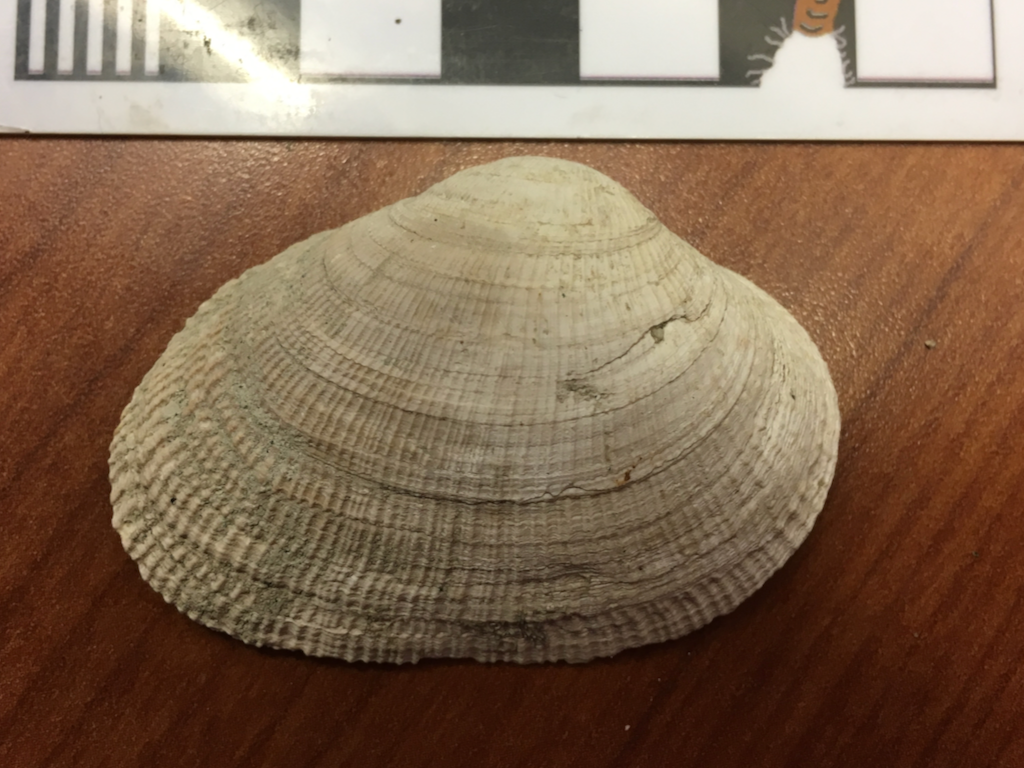 At the end of this month WSC is opening a new exhibit, "Life in the Ancient Seas". A big portion of the staff's efforts are currently focused on getting this ready, including writing labels for individual specimens; this may be the largest exhibit we've ever done in terms of shear specimen count! But sometimes these labels can be difficult to write, as the information is often obscure.This shell comes from Pliocene deposits near Chuckatuck, Virginia, specifically the Moore House Member of the Yorktown Formation. We have a small collection from this site at WSC, numbering perhaps 200-300 shells. Ten of them are from this species. This is a site I'm quite familiar with; I collected there numerous times when I worked at the Virginia Museum of Natural History, and in fact Brett collected this specimen on a field trip I ran there about 10 years ago. My first job at VMNH was sorting fossil mollusks from this and other localities, so while I'm not an expert on Pliocene mollusks I'm probably more familiar with them than is typical for a vertebrate paleontologist.This shell had me stumped, though. At first I thought it was from the genus Striarca, like the example below from the Marine Life Encyclopedia:
At the end of this month WSC is opening a new exhibit, "Life in the Ancient Seas". A big portion of the staff's efforts are currently focused on getting this ready, including writing labels for individual specimens; this may be the largest exhibit we've ever done in terms of shear specimen count! But sometimes these labels can be difficult to write, as the information is often obscure.This shell comes from Pliocene deposits near Chuckatuck, Virginia, specifically the Moore House Member of the Yorktown Formation. We have a small collection from this site at WSC, numbering perhaps 200-300 shells. Ten of them are from this species. This is a site I'm quite familiar with; I collected there numerous times when I worked at the Virginia Museum of Natural History, and in fact Brett collected this specimen on a field trip I ran there about 10 years ago. My first job at VMNH was sorting fossil mollusks from this and other localities, so while I'm not an expert on Pliocene mollusks I'm probably more familiar with them than is typical for a vertebrate paleontologist.This shell had me stumped, though. At first I thought it was from the genus Striarca, like the example below from the Marine Life Encyclopedia: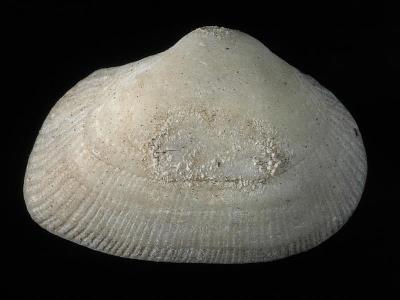 But a quick look at the other side of the shell ruled this out. Striarca is a member of the order Arcoidea, which have very distinctive hinges. But the Chuckatuck shell had a different hinge, that looked to me like a member of the Veneroida. Below, the first image is Striarca (from WoRMS), while the second is the Chuckatuck shell:
But a quick look at the other side of the shell ruled this out. Striarca is a member of the order Arcoidea, which have very distinctive hinges. But the Chuckatuck shell had a different hinge, that looked to me like a member of the Veneroida. Below, the first image is Striarca (from WoRMS), while the second is the Chuckatuck shell: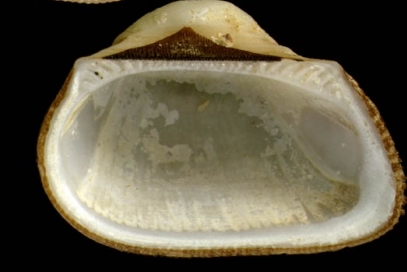
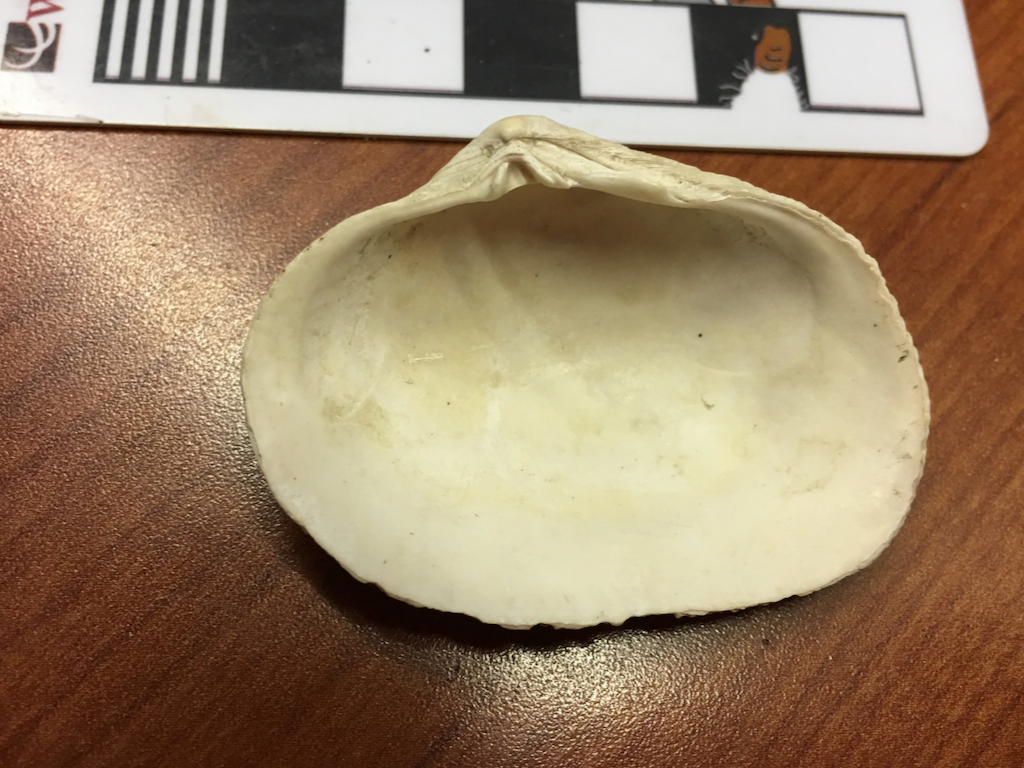 The problem was that none of the references I had at hand seemed to include a veneroid that matched both the size and appearance of this shell. Image searches online were not producing much of use, so I went to Twitter. Within a day or so I got a response:
The problem was that none of the references I had at hand seemed to include a veneroid that matched both the size and appearance of this shell. Image searches online were not producing much of use, so I went to Twitter. Within a day or so I got a response: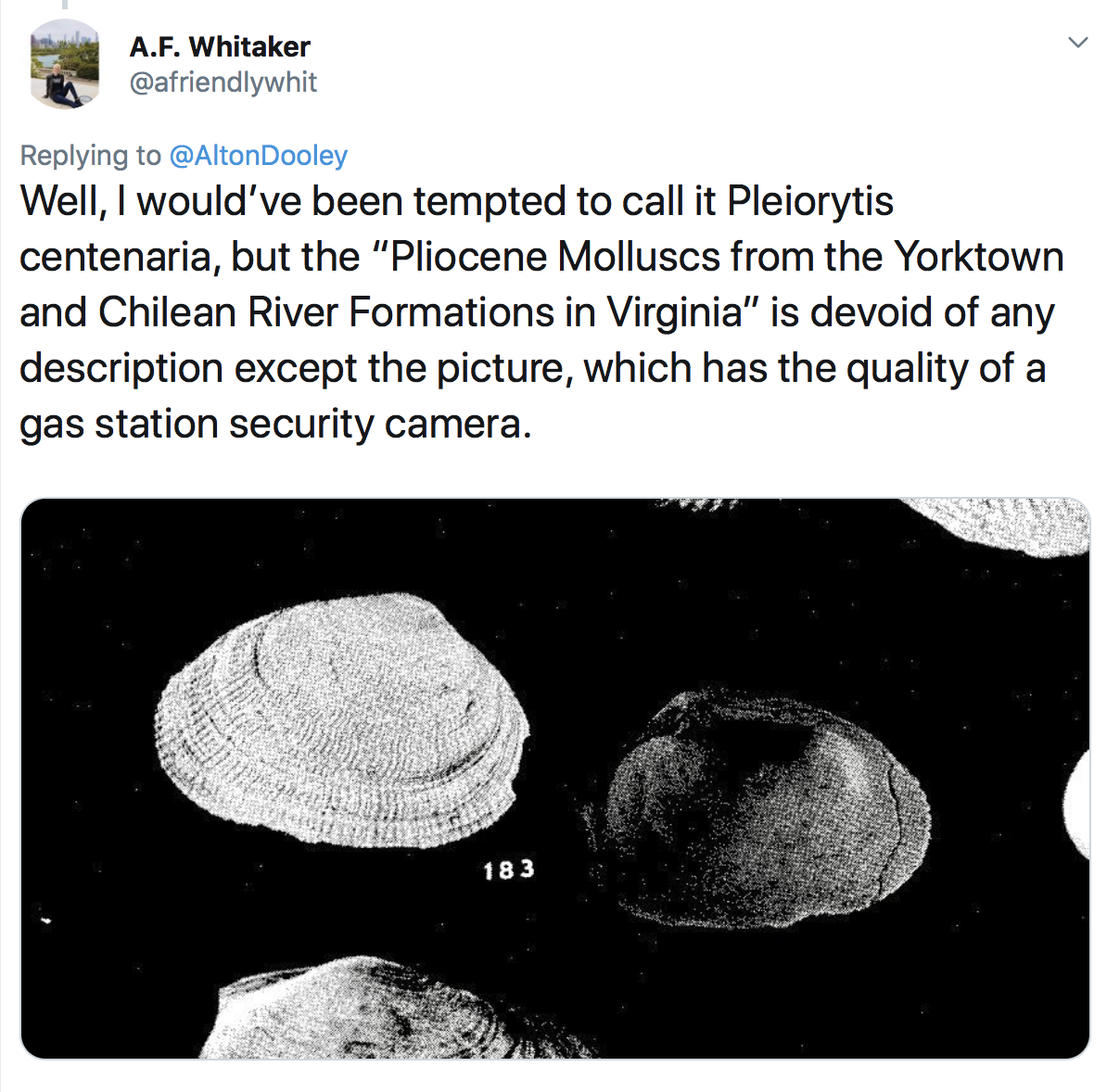 Unfortunately searches for Pleiorytis centenaria didn't turn up much. But then I received another Twitter response:
Unfortunately searches for Pleiorytis centenaria didn't turn up much. But then I received another Twitter response: So that solved it! Asaphis is a veneroid, a member of a family known as the sunset clams. There's even a photo online of Asaphis centenaria from the Pliocene Tamiami Formation of Florida:
So that solved it! Asaphis is a veneroid, a member of a family known as the sunset clams. There's even a photo online of Asaphis centenaria from the Pliocene Tamiami Formation of Florida: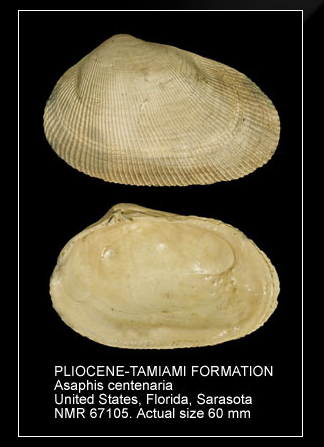 So, mystery solved! And this allows us to display the particular specimen that I wanted to include in the exhibit:
So, mystery solved! And this allows us to display the particular specimen that I wanted to include in the exhibit: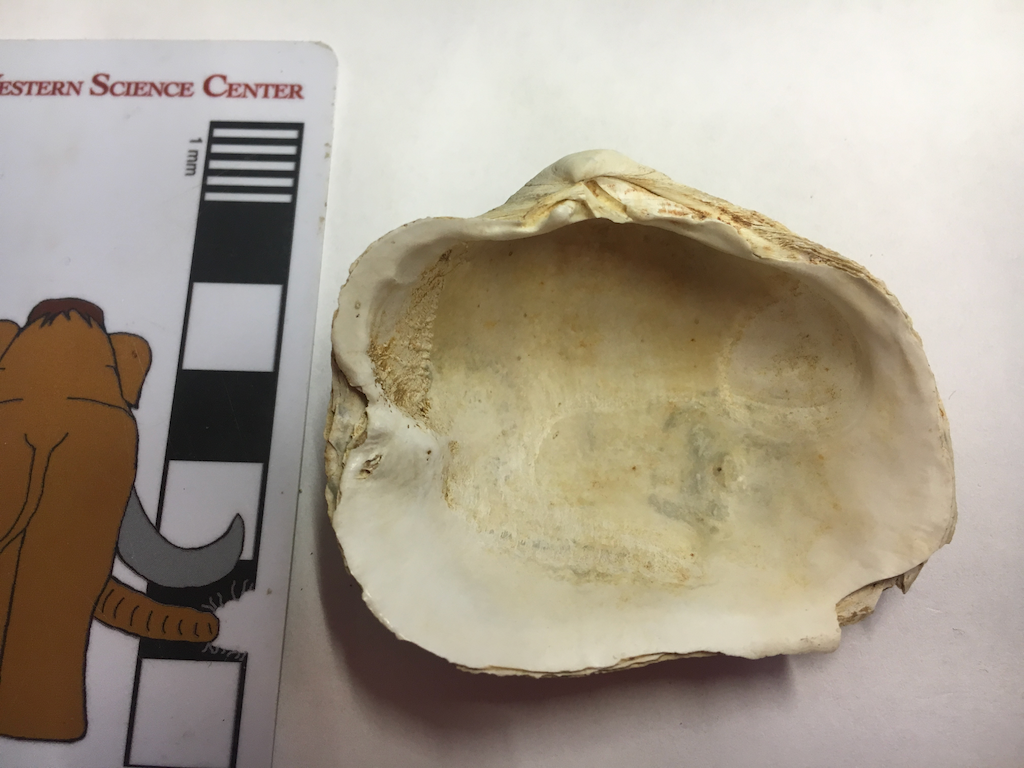 Notice the odd wrinkle on the left side of the shell. While Asaphis and other clams are sometimes misshapen because of where they happen to be growing, I don't think that's what happened here, because I've seen similar wrinkles in shells from mobile taxa, such as scallops. This looks like the clam suffered a non-fatal injury at some point. Perhaps a crab or some other predator tried to crack open the shell. The attack was unsuccessful, but it did some damage and the crab repaired the damage by depositing new shell layers over the injury as it grew. I love features like this, traces that give us glimpses into the daily lives of organisms that happened millions of years in the past.Thanks to @afriendlywhit and @paleomollusk for their help with this identification. "Life in the Ancient Seas" opens to the public on August 31.
Notice the odd wrinkle on the left side of the shell. While Asaphis and other clams are sometimes misshapen because of where they happen to be growing, I don't think that's what happened here, because I've seen similar wrinkles in shells from mobile taxa, such as scallops. This looks like the clam suffered a non-fatal injury at some point. Perhaps a crab or some other predator tried to crack open the shell. The attack was unsuccessful, but it did some damage and the crab repaired the damage by depositing new shell layers over the injury as it grew. I love features like this, traces that give us glimpses into the daily lives of organisms that happened millions of years in the past.Thanks to @afriendlywhit and @paleomollusk for their help with this identification. "Life in the Ancient Seas" opens to the public on August 31.
Fossil Friday - abelone
 Last week Cogstone Resource Management (http://www.cogstone.com) delivered a collection of Pleistocene deposits from Ventura County to the Western Science Center. This included a number of both vertebrate and invertebrate fossils.These photos show a shell from an abelone, Haliotis sp.. While the shell looks a lot like a clam, abelone are actually snails; the light-colored early whirls of the shell are visible adjacent to the scale bar. It's also clear on the other side of the shell that it's not from a clam, as there is no hinge line to articulate with a second shell (below). This view also shows off the opalescence for which abelone are famous.
Last week Cogstone Resource Management (http://www.cogstone.com) delivered a collection of Pleistocene deposits from Ventura County to the Western Science Center. This included a number of both vertebrate and invertebrate fossils.These photos show a shell from an abelone, Haliotis sp.. While the shell looks a lot like a clam, abelone are actually snails; the light-colored early whirls of the shell are visible adjacent to the scale bar. It's also clear on the other side of the shell that it's not from a clam, as there is no hinge line to articulate with a second shell (below). This view also shows off the opalescence for which abelone are famous. Abelone typically live in fairly shallow water just below the intertidal zone, where they feed on algae. Associated fossils in this collection also indicate a similar shallow marine setting.This abelone and other fossils from this site will be featured in an exhibit opening at WSC this fall. Thanks to Cogstone for bringing it to us!
Abelone typically live in fairly shallow water just below the intertidal zone, where they feed on algae. Associated fossils in this collection also indicate a similar shallow marine setting.This abelone and other fossils from this site will be featured in an exhibit opening at WSC this fall. Thanks to Cogstone for bringing it to us!
Fossil Friday - community on a half-shell
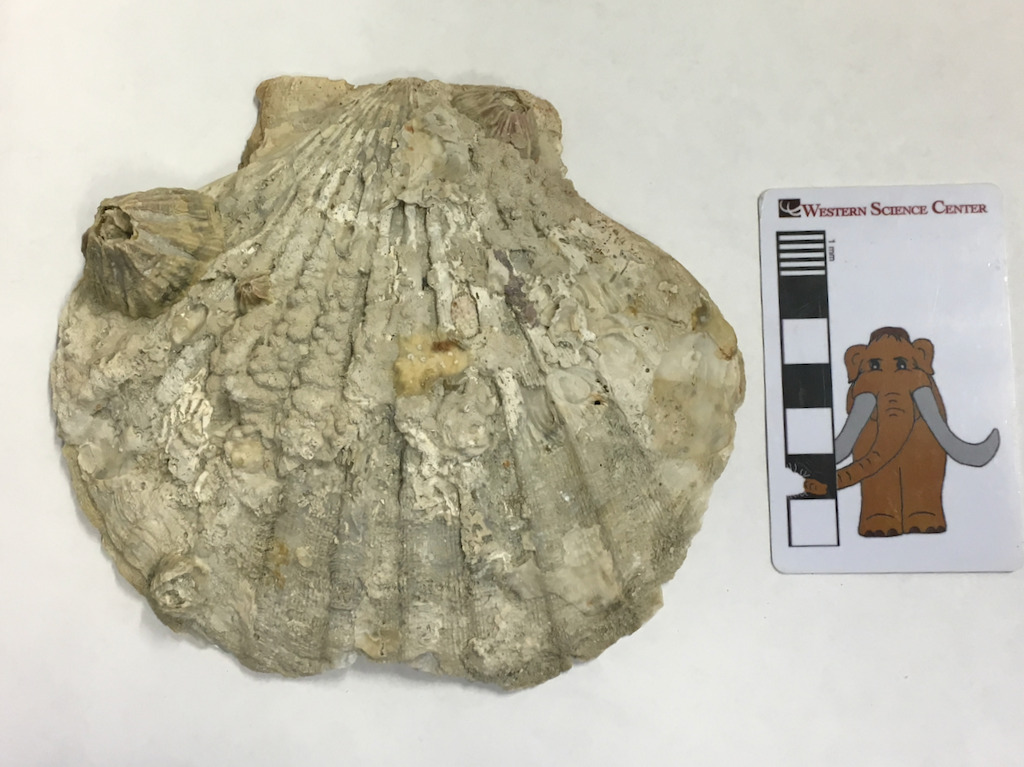 Life as a suspension feeder is a mixed blessing. Most suspension feeders are sessile, staying in one place for practically their entire life. They feed by extracting food particles from water, using a bewildering variety of suction tubes, mucus nets, feathery appendages, and various other anatomical variations. Almost every phylum of animals and many protists include examples of suspension feeders. It's a lifestyle that could be regarded almost as idyllic, as you sway back and forth in the current, waiting on food to blunder into your mouth (for those suspension feeders that actually have mouths; not all do). But it can be treacherous, too. Those same currents that bring you your food can also rip you from your anchor point, carrying you off, where you may ironically end up as food for some other suspension feeder. Attaching to a solid, stable substrate is critical to survival for a suspension feeder, and in some environments there is a lot of competition for good spots.Above is a shell of the extinct scallop Chesapecten madisonius, a species that was abundant in warm-temperate waters of the western Atlantic during the Pliocene. This example came from a quarry near Chuckatuck, Virginia, from the 3-million-year-old Yorktown Formation. Scallops are suspension feeders, although they are capable of moving around. When they died, their large (up to the size of a dinner plate!) calcium carbonate shells would end up lying on the seafloor.At this particular location, the sediment is almost all sand, with huge numbers of broken seashells. Both the sediment and types and preservation of the shells indicate that this was an offshore shoaling area where waves were breaking in shallow water. With the constant water flow this was a great environment for suspension feeders, but the high energy and unconsolidated sandy bottom mean that hard substrates for attachment were at a premium. A large mineralized seashell sitting on the seafloor was too good to pass up, and a whole community of suspension feeders took advantage and settled on the shell.Some of these organisms are gone, but left traces behind indicating their presence. There are several pits at various places on the shell:
Life as a suspension feeder is a mixed blessing. Most suspension feeders are sessile, staying in one place for practically their entire life. They feed by extracting food particles from water, using a bewildering variety of suction tubes, mucus nets, feathery appendages, and various other anatomical variations. Almost every phylum of animals and many protists include examples of suspension feeders. It's a lifestyle that could be regarded almost as idyllic, as you sway back and forth in the current, waiting on food to blunder into your mouth (for those suspension feeders that actually have mouths; not all do). But it can be treacherous, too. Those same currents that bring you your food can also rip you from your anchor point, carrying you off, where you may ironically end up as food for some other suspension feeder. Attaching to a solid, stable substrate is critical to survival for a suspension feeder, and in some environments there is a lot of competition for good spots.Above is a shell of the extinct scallop Chesapecten madisonius, a species that was abundant in warm-temperate waters of the western Atlantic during the Pliocene. This example came from a quarry near Chuckatuck, Virginia, from the 3-million-year-old Yorktown Formation. Scallops are suspension feeders, although they are capable of moving around. When they died, their large (up to the size of a dinner plate!) calcium carbonate shells would end up lying on the seafloor.At this particular location, the sediment is almost all sand, with huge numbers of broken seashells. Both the sediment and types and preservation of the shells indicate that this was an offshore shoaling area where waves were breaking in shallow water. With the constant water flow this was a great environment for suspension feeders, but the high energy and unconsolidated sandy bottom mean that hard substrates for attachment were at a premium. A large mineralized seashell sitting on the seafloor was too good to pass up, and a whole community of suspension feeders took advantage and settled on the shell.Some of these organisms are gone, but left traces behind indicating their presence. There are several pits at various places on the shell: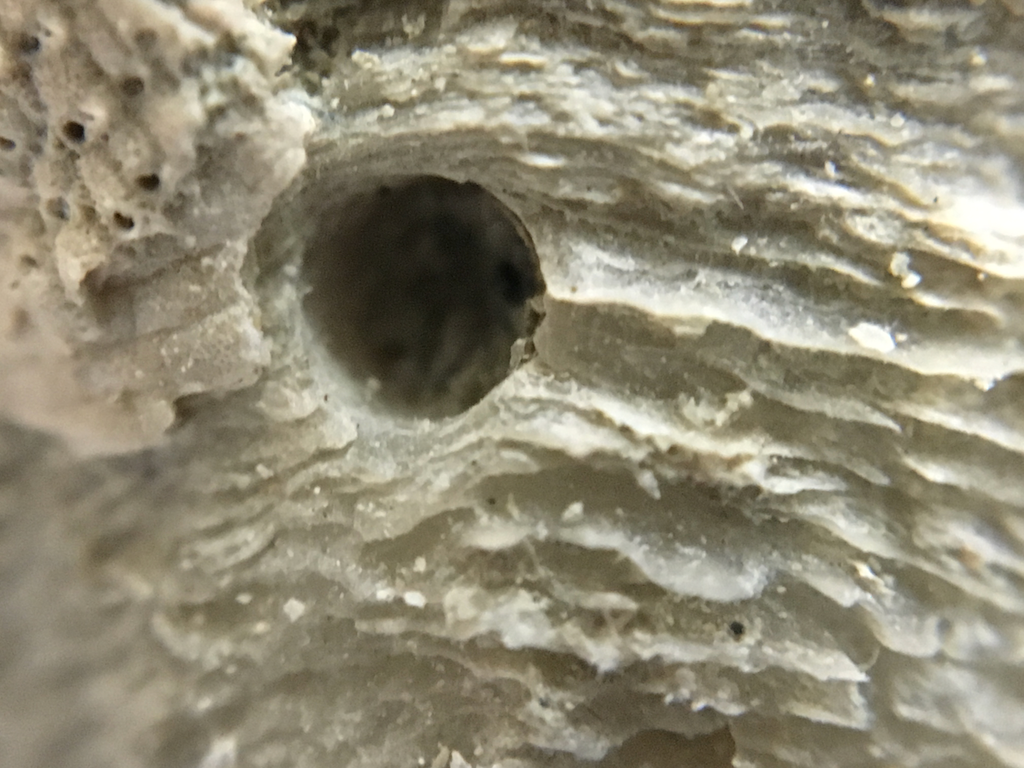
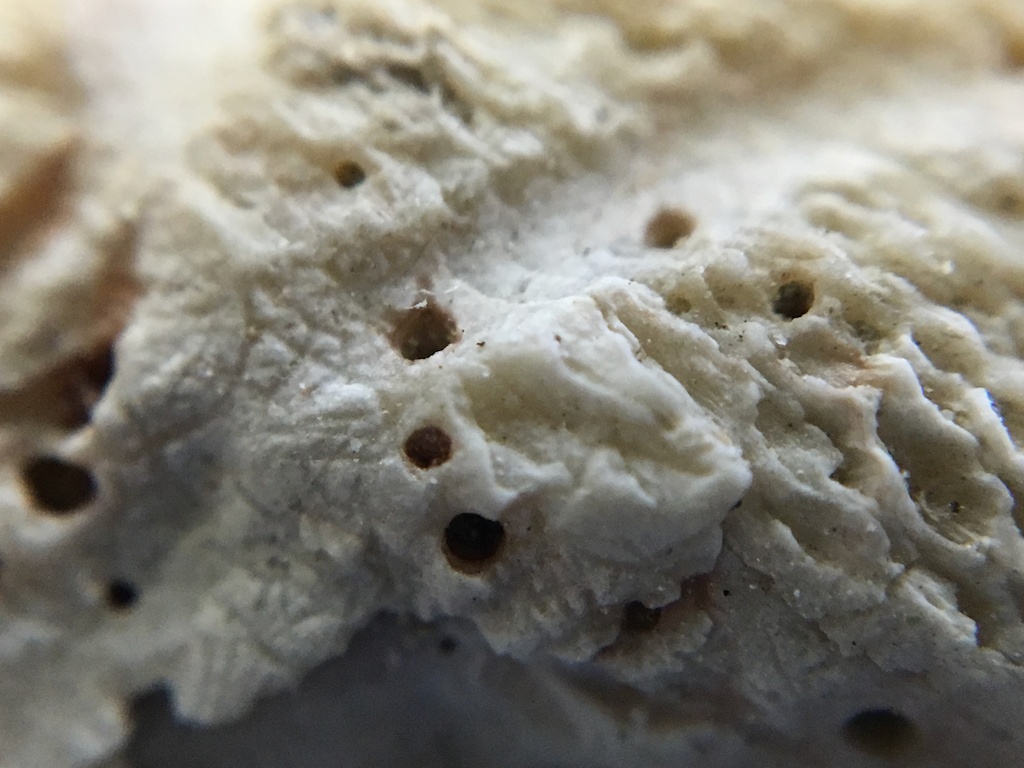 A few of these were probably made by predatory snails that attack other mollusks by drilling into their shells. Others were likely formed by cloned sponges, which chemically dissolve part of the target shell to provide living space.In other areas, parts of the shell have been broadly removed, leaving shallow sculpted depressions:
A few of these were probably made by predatory snails that attack other mollusks by drilling into their shells. Others were likely formed by cloned sponges, which chemically dissolve part of the target shell to provide living space.In other areas, parts of the shell have been broadly removed, leaving shallow sculpted depressions: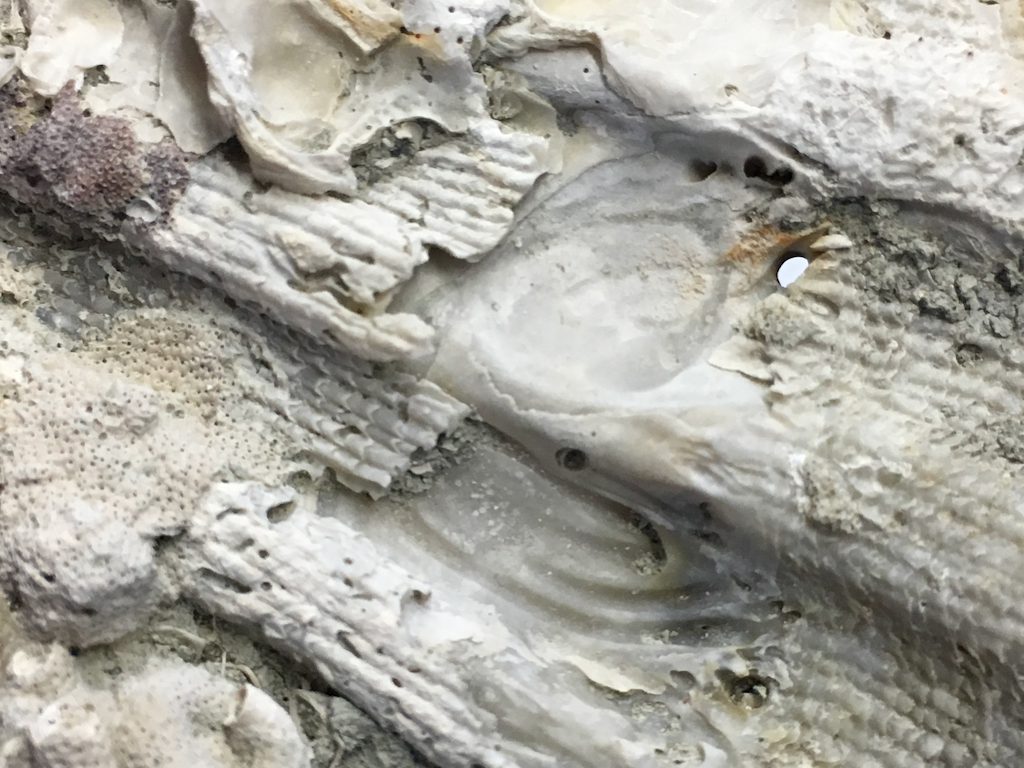 These were likely produced by another mollusk, possibly slipper snails such as Crepidula or boring clams from the family that includes shipworms (which are actually clams). Some were definitely clams of some sort, because one of the shells is still there (although I've not yet been able to identify the species):
These were likely produced by another mollusk, possibly slipper snails such as Crepidula or boring clams from the family that includes shipworms (which are actually clams). Some were definitely clams of some sort, because one of the shells is still there (although I've not yet been able to identify the species):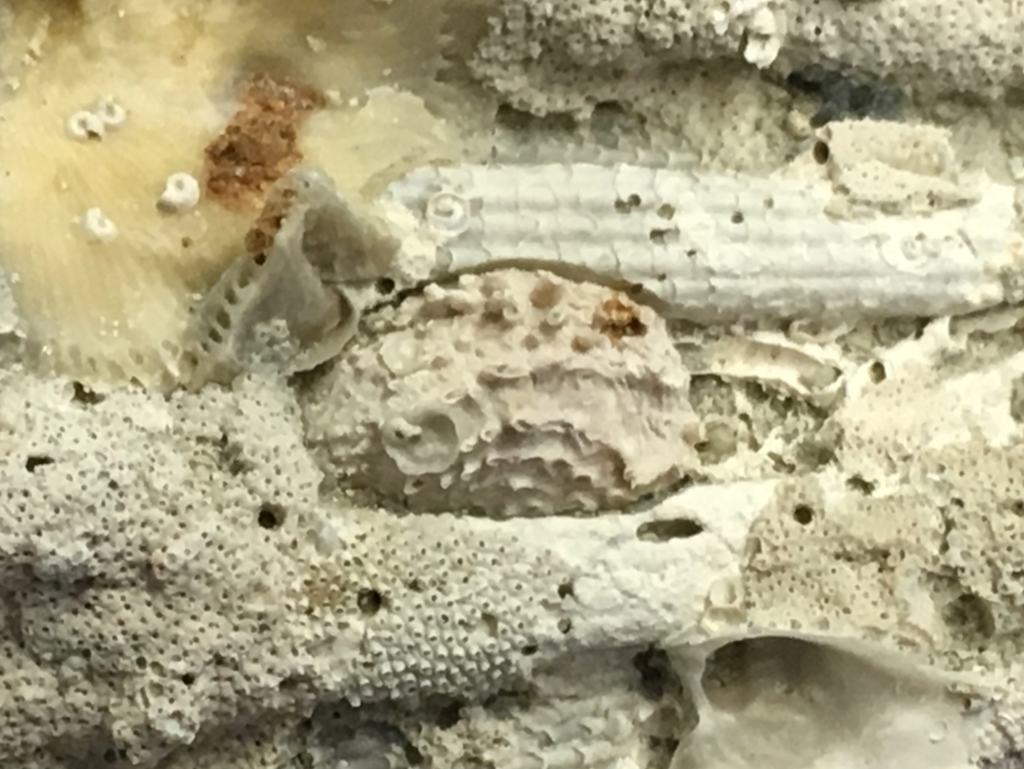 In many cases the colonizing organisms' shells are still present. The most obvious are these volcano-shaped structures:
In many cases the colonizing organisms' shells are still present. The most obvious are these volcano-shaped structures: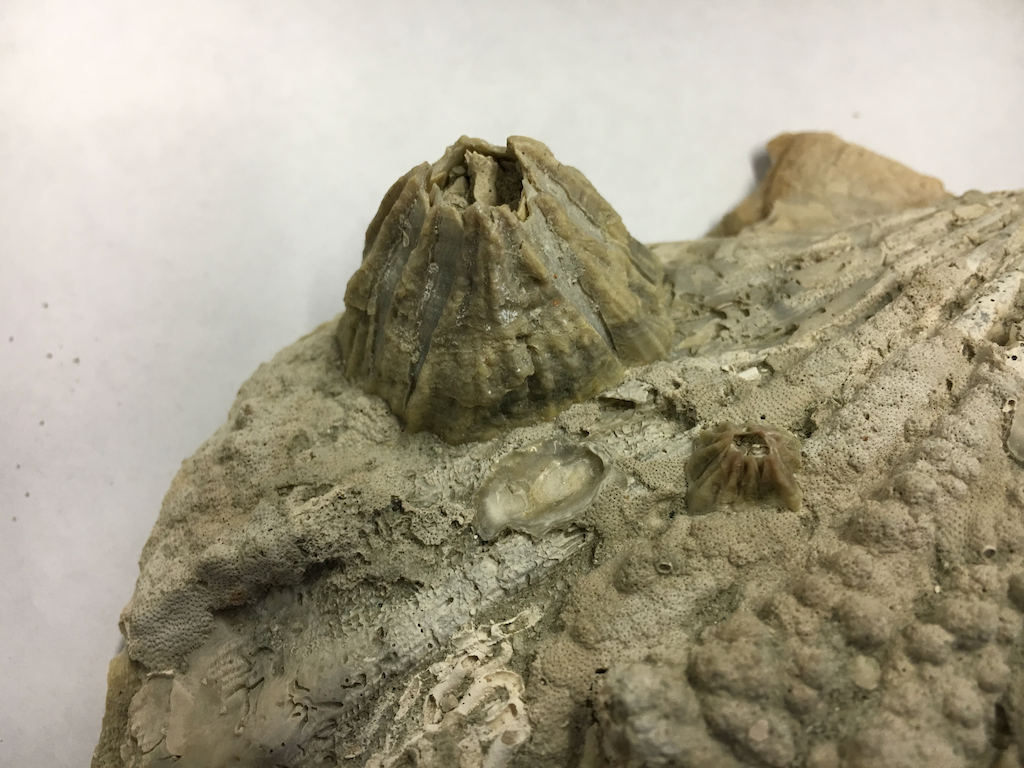 These are barnacles, sessile suspension-feeding crustaceans that are distantly related to shrimp (as a nod to the evolutionary imagination of suspension feeders, they collect food by waving their hairy legs around in the water). Sitting between two barnacles is (I think) an attachment point for an oyster:
These are barnacles, sessile suspension-feeding crustaceans that are distantly related to shrimp (as a nod to the evolutionary imagination of suspension feeders, they collect food by waving their hairy legs around in the water). Sitting between two barnacles is (I think) an attachment point for an oyster: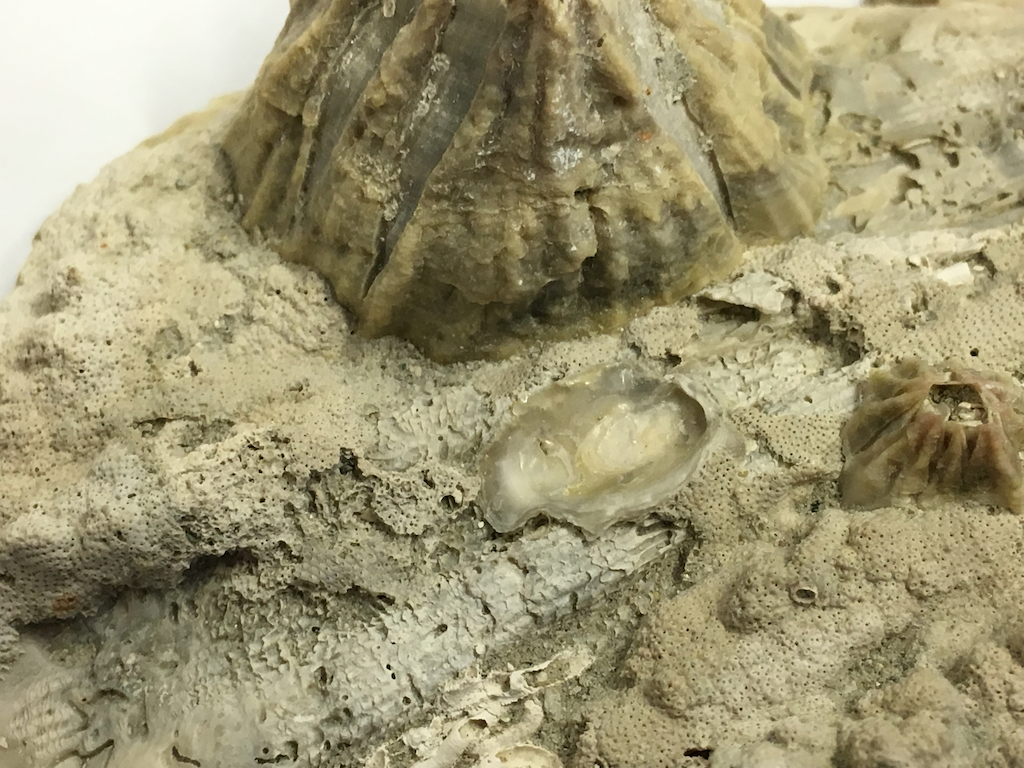 Nearby are small carbonate tubes. I believe these are tubes from polychaete worms (there are also clams that build carbonate tubes, but I'm pretty sure these are from worms):
Nearby are small carbonate tubes. I believe these are tubes from polychaete worms (there are also clams that build carbonate tubes, but I'm pretty sure these are from worms):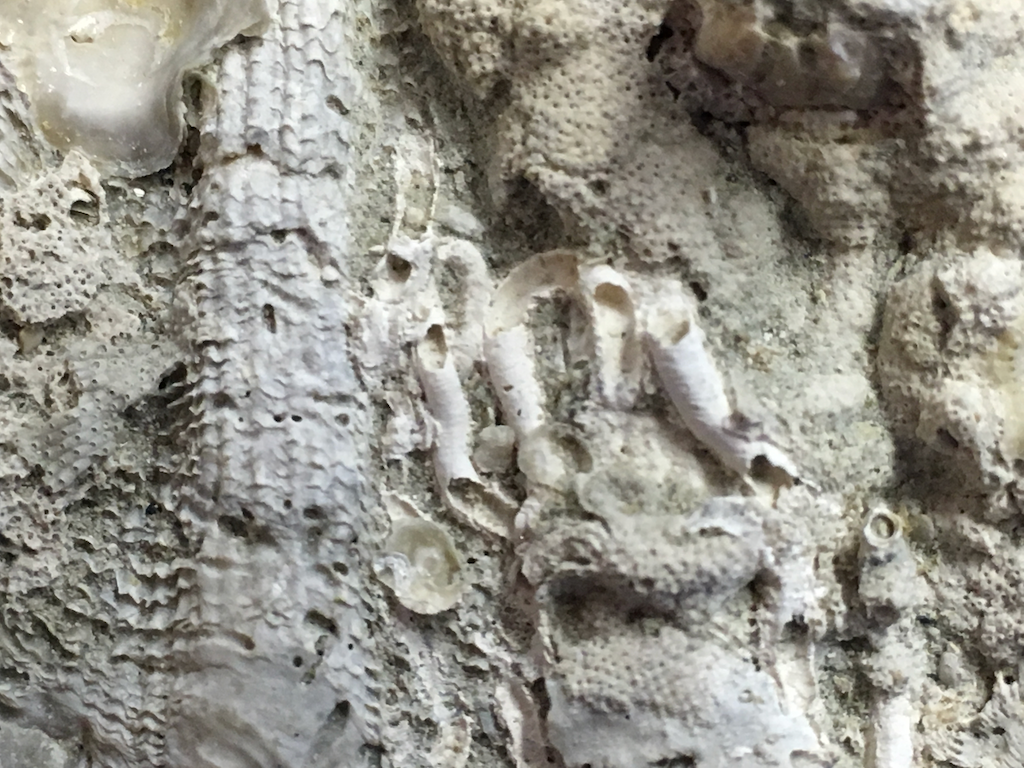 In terms of coverage area, the most extensive colonizers on this shell are bryozoans, or moss animals. These are colonial animals that are placed in their own phylum. Here's one of the larger colonies on this shell:
In terms of coverage area, the most extensive colonizers on this shell are bryozoans, or moss animals. These are colonial animals that are placed in their own phylum. Here's one of the larger colonies on this shell: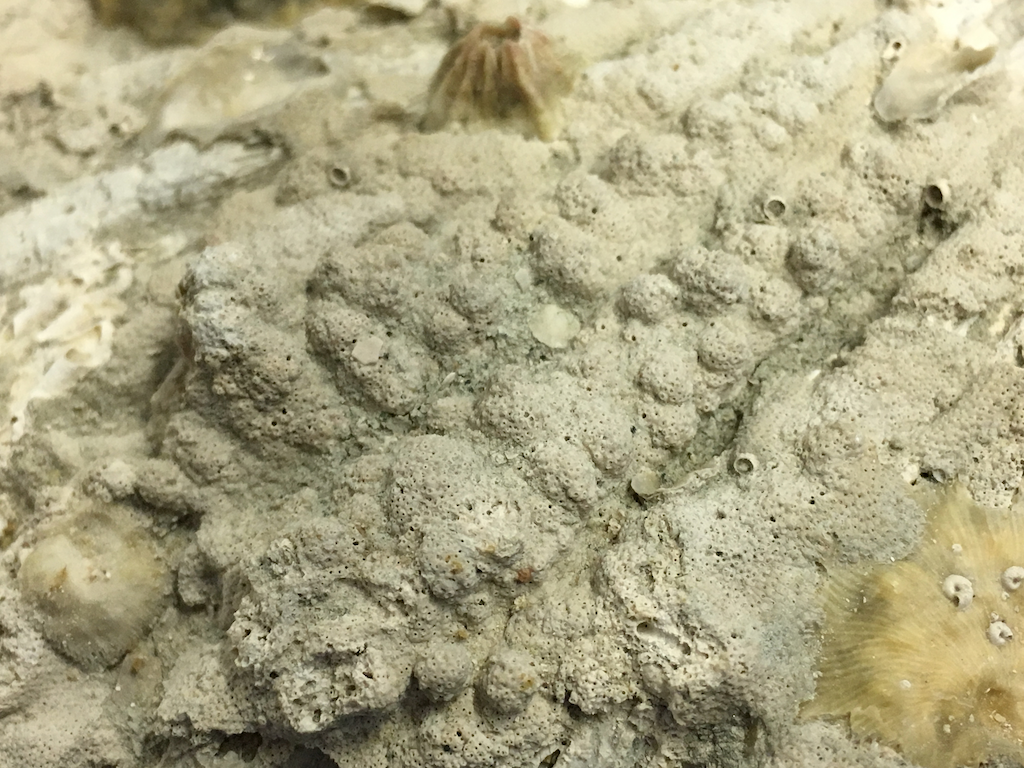 Zooming in close, we can see the individual animals ("zooids") in the colony; each hole contained a zooid:
Zooming in close, we can see the individual animals ("zooids") in the colony; each hole contained a zooid: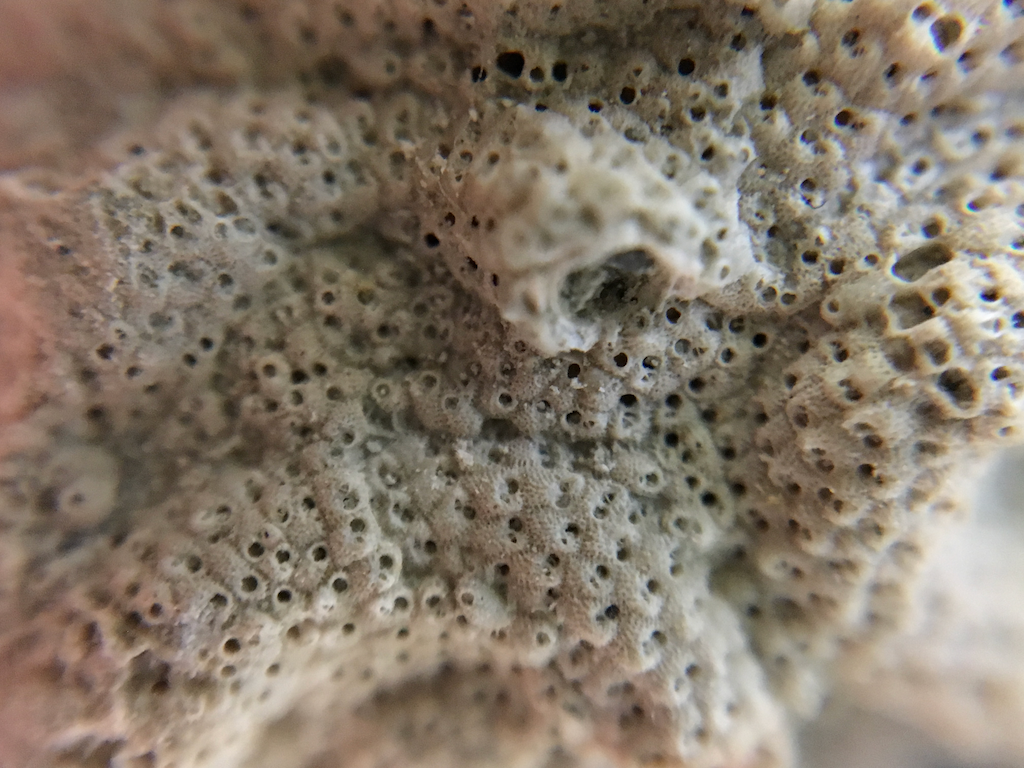 It seems that this shell was colonized by at least two species of bryozoans, because there's another area where the zooids look rather different:
It seems that this shell was colonized by at least two species of bryozoans, because there's another area where the zooids look rather different: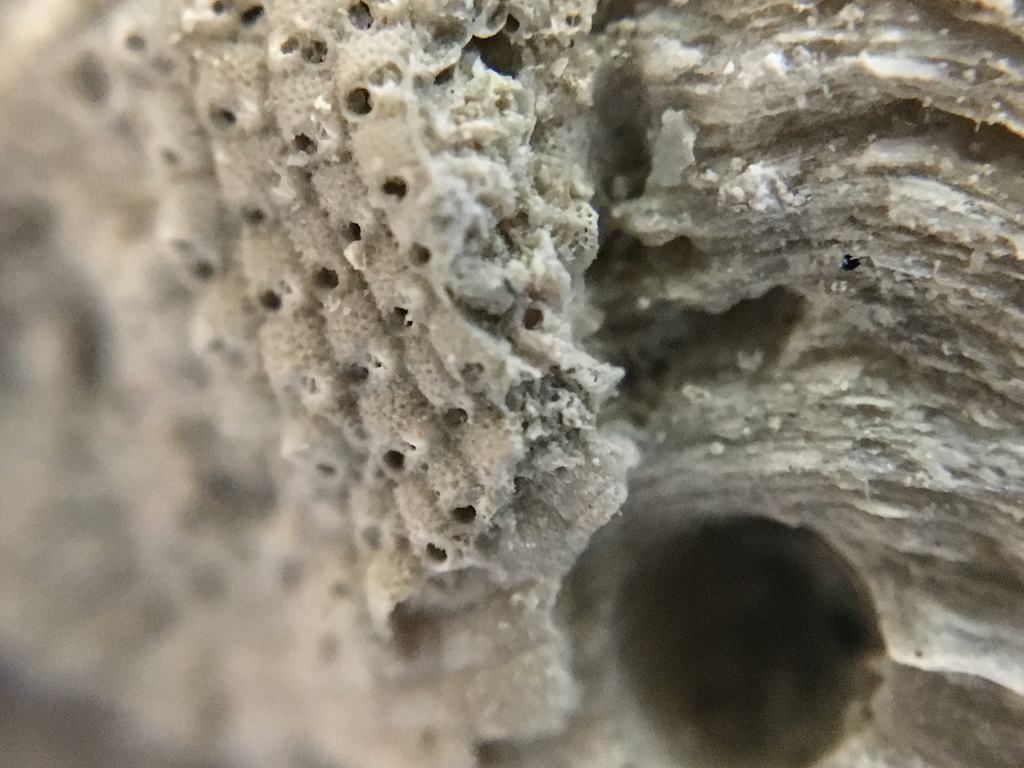 Finally, there's one I'm really uncertain about. There's one patch (the yellowish area at the center of the shell in the top image) where a barnacle attached itself on top of the bryozoan colony, and then fell off (the yellow area is the base of the barnacle). But, on top of that, there are a handful of tiny spiral shells, the largest of which is just under 1 mm in diameter:
Finally, there's one I'm really uncertain about. There's one patch (the yellowish area at the center of the shell in the top image) where a barnacle attached itself on top of the bryozoan colony, and then fell off (the yellow area is the base of the barnacle). But, on top of that, there are a handful of tiny spiral shells, the largest of which is just under 1 mm in diameter: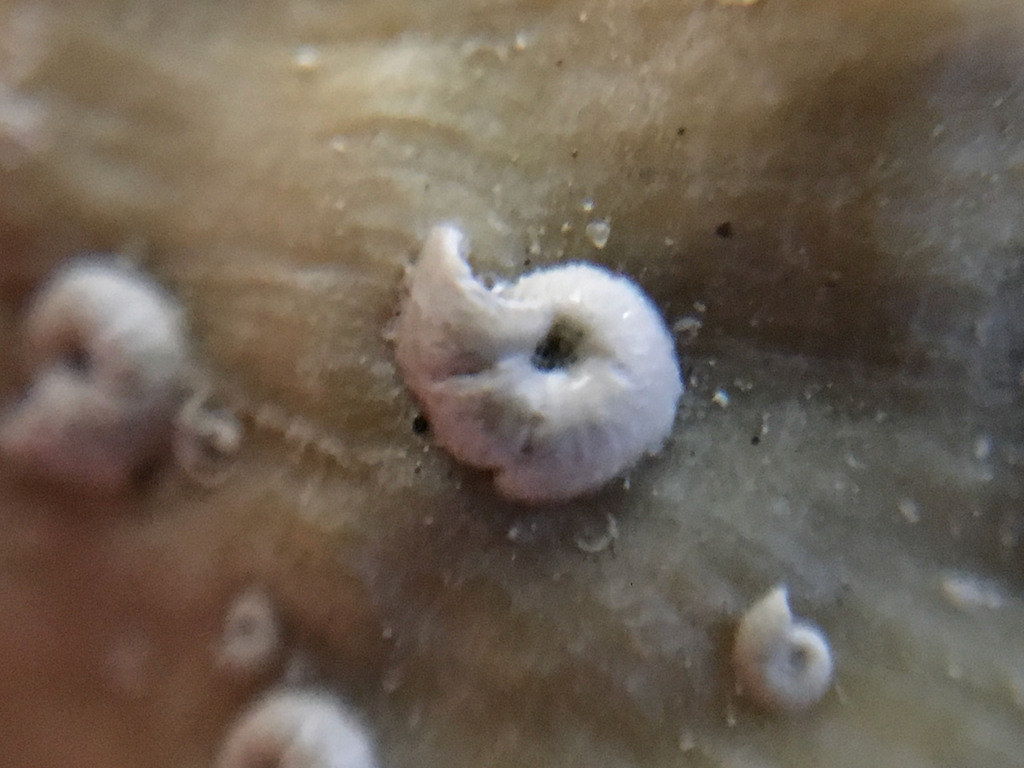 I'm not completely sure of my identification here, but I think these are benthic foraminifera. Foraminifera are amoeba-like, single-celled protists that secrete a calcium carbonate shell (in most species). There are perhaps a dozen of these visible, in addition to places where they were clearly present at one time and later removed.So, assuming all my identifications are correct, and counting everything up, this single Chesapecten shell supported:
I'm not completely sure of my identification here, but I think these are benthic foraminifera. Foraminifera are amoeba-like, single-celled protists that secrete a calcium carbonate shell (in most species). There are perhaps a dozen of these visible, in addition to places where they were clearly present at one time and later removed.So, assuming all my identifications are correct, and counting everything up, this single Chesapecten shell supported:
- A sponge
- At least a half-dozen bivalves, from at least two species
- At least 10 barnacles
- At least a dozen polychaete worms
- At least two bryozoan species each with several hundred individuals
- At least a dozen foraminifera
Not bad for a single seashell!
Fossil Friday - freshwater snail
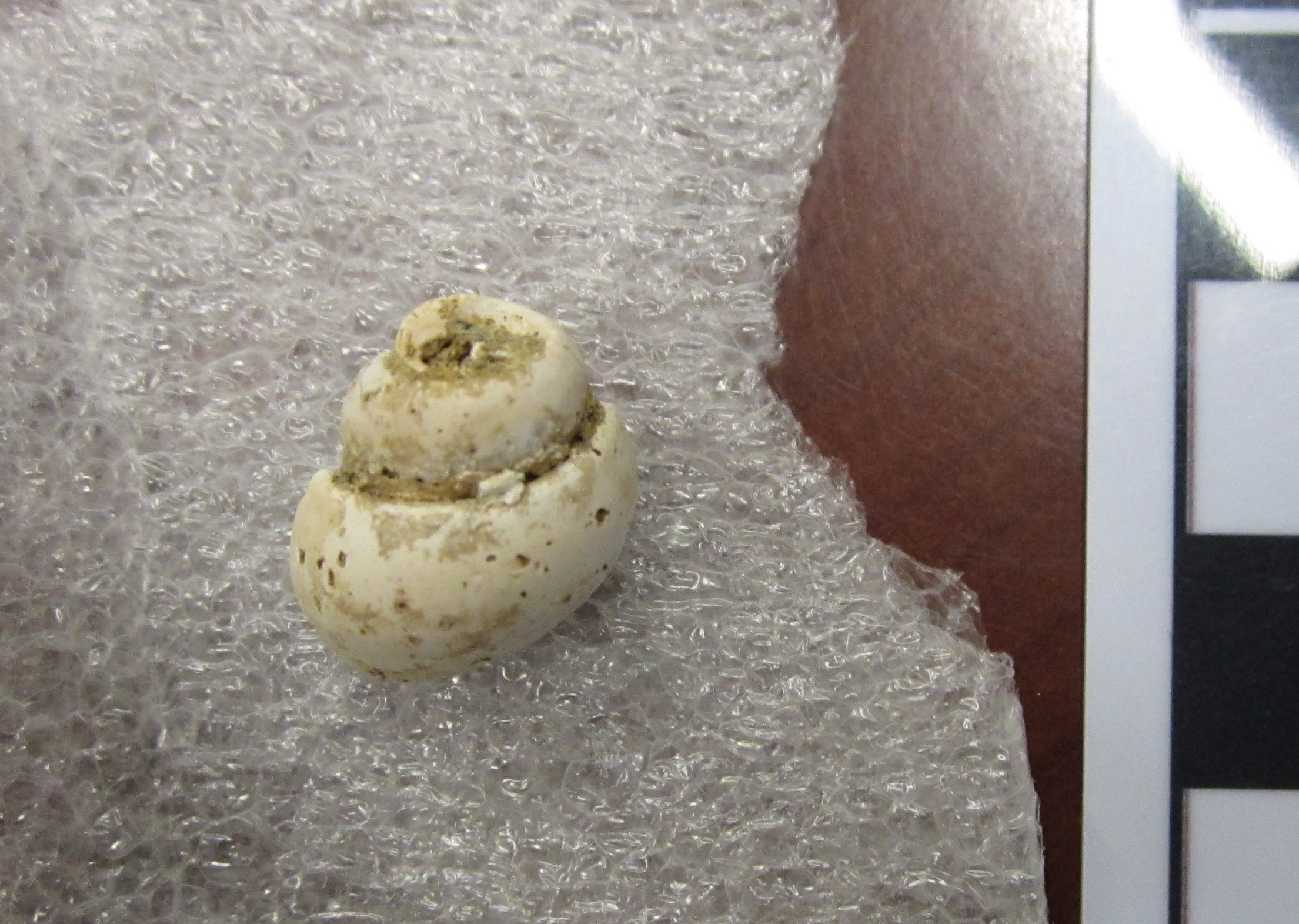 The world of the dinosaurs was populated by some of the most gargantuan and charismatic animals ever to roam our planet. It is easy to forget that the Mesozoic Era was just as rich with all sorts of life as our modern world. This is the shell of a freshwater snail called Campeloma. This shell was collected by the late Harley Garbani and is part of a collection donated to the Western Science Center by his wife, Mary.This Campeloma was found in the Hell Creek Formation of Montana and is about 67 million years old (Late Cretaceous Epoch). While this little snail scooted along the bottom of ponds and streams, the last of the giant dinosaurs, such as Tyrannosaurus andTriceratops, thundered across the land. Living species of Campeloma still inhabit freshwater environments in the United States and Canada.
The world of the dinosaurs was populated by some of the most gargantuan and charismatic animals ever to roam our planet. It is easy to forget that the Mesozoic Era was just as rich with all sorts of life as our modern world. This is the shell of a freshwater snail called Campeloma. This shell was collected by the late Harley Garbani and is part of a collection donated to the Western Science Center by his wife, Mary.This Campeloma was found in the Hell Creek Formation of Montana and is about 67 million years old (Late Cretaceous Epoch). While this little snail scooted along the bottom of ponds and streams, the last of the giant dinosaurs, such as Tyrannosaurus andTriceratops, thundered across the land. Living species of Campeloma still inhabit freshwater environments in the United States and Canada.
Fossil Friday - Aviculopecten
 During last week's Valley of the Mastodons events, museum supporter Doug Shore donated a collection of invertebrate and plant fossils to Western Science Center. Several of Doug's specimens come from Mason Creek, an incredibly rich Carboniferous site in Illinois that is most famous for its beautiful fossil plants. While WSC has a large collection of Mason Creek plants, we did not have any of the numerous animals also found at the site until now.Above are two specimens of the mollusk Aviculopecten mazonensis, a scallop. At least, I think it's two specimens. As the name states, bivalve mollusk have two valves or shells. In many bivalves these two shells look quite different from each other, but in the pectinids (scallops) they are often very similar (although one valve tends to be deeper than the other). In this case the two valves have slightly different dimensions and both seem to have the same curvature, making me suspect they represent two individuals rather than two shells from one individual. Thanks to Doug for this nice addition to the WSC collection!
During last week's Valley of the Mastodons events, museum supporter Doug Shore donated a collection of invertebrate and plant fossils to Western Science Center. Several of Doug's specimens come from Mason Creek, an incredibly rich Carboniferous site in Illinois that is most famous for its beautiful fossil plants. While WSC has a large collection of Mason Creek plants, we did not have any of the numerous animals also found at the site until now.Above are two specimens of the mollusk Aviculopecten mazonensis, a scallop. At least, I think it's two specimens. As the name states, bivalve mollusk have two valves or shells. In many bivalves these two shells look quite different from each other, but in the pectinids (scallops) they are often very similar (although one valve tends to be deeper than the other). In this case the two valves have slightly different dimensions and both seem to have the same curvature, making me suspect they represent two individuals rather than two shells from one individual. Thanks to Doug for this nice addition to the WSC collection!
Fossil Friday - pea clam
 While the Diamond Valley Lake fossil fauna is best known for its mammals, there were also thousands of mollusks recovered. These are mostly minute freshwater species, and even though we have thousands of them the all fit easily in a single specimen case.While most of these mollusks are gastropods (snails), there are some bivalves as well. Above is the right valve of a pea clam, Pisidium, shown in lateral or exterior view. The alternating black and white lines in the background are each 1 mm wide. Below is the same shell in interior view:
While the Diamond Valley Lake fossil fauna is best known for its mammals, there were also thousands of mollusks recovered. These are mostly minute freshwater species, and even though we have thousands of them the all fit easily in a single specimen case.While most of these mollusks are gastropods (snails), there are some bivalves as well. Above is the right valve of a pea clam, Pisidium, shown in lateral or exterior view. The alternating black and white lines in the background are each 1 mm wide. Below is the same shell in interior view: The shell's hinge, where the left valve would have attached, is visible along the lower left margin of the shell. Inside the shell, you can just make out the adductor scar; this is the attachment point for the muscles that close the shell.As I've been discovering, it's difficult to find a lot of information online about freshwater mollusks. Pisidium is a widespread extant genus, found in (at least) Eurasia, Africa, and North America. It appears that many of the modern species found in North America are invasive species from Europe, but clearly the genus was present here long before the arrival of Europeans.
The shell's hinge, where the left valve would have attached, is visible along the lower left margin of the shell. Inside the shell, you can just make out the adductor scar; this is the attachment point for the muscles that close the shell.As I've been discovering, it's difficult to find a lot of information online about freshwater mollusks. Pisidium is a widespread extant genus, found in (at least) Eurasia, Africa, and North America. It appears that many of the modern species found in North America are invasive species from Europe, but clearly the genus was present here long before the arrival of Europeans.
Fossils of my youth
 Inspired by the #GatewayFossil hashtag on Twitter, I'm reposting this piece that I originally published at "Updates from the Paleontology Lab" on June 9, 2009.My first exposure to fossils in the field (as opposed to in a museum) occurred when I was around 5 years old.When my father was a teenager he used to hunt with my grandfather in the mountains along the Botetourt-Craig County line in western Virginia, where he had casually noticed some fossils in the stream gravels (I’m not sure he knew at the time what they were). My mother has always had an interest in rocks and fossils (due to the influence of her grandfather), so my dad used to take us up to that area to look for fossils. We mostly found molds of crinoid column segments and occasional brachiopods in a brown sandstone (above). With the limited resources available to a relatively poor child growing up in the country at that time (no internet!), I didn’t know much more about those fossils, and doing my college work in Minnesota and Louisiana I never actually learned much about the rocks I collected in my youth, a point that was emphasized with the discovery last year of the Boxley stromatolite in Bedford County (where I grew up).Now that I’m back in Virginia with years of geologic training behind me I can look at these rocks in a new light. Last Friday, my father and I spent the day driving around Botetourt and Craig Counties, looking at rocks. Near Webster, VA we stopped at a railroad trestle close to the Blue Ridge Fault, with deformed Cambrian Rome Formation exposed in the trestle foundation:
Inspired by the #GatewayFossil hashtag on Twitter, I'm reposting this piece that I originally published at "Updates from the Paleontology Lab" on June 9, 2009.My first exposure to fossils in the field (as opposed to in a museum) occurred when I was around 5 years old.When my father was a teenager he used to hunt with my grandfather in the mountains along the Botetourt-Craig County line in western Virginia, where he had casually noticed some fossils in the stream gravels (I’m not sure he knew at the time what they were). My mother has always had an interest in rocks and fossils (due to the influence of her grandfather), so my dad used to take us up to that area to look for fossils. We mostly found molds of crinoid column segments and occasional brachiopods in a brown sandstone (above). With the limited resources available to a relatively poor child growing up in the country at that time (no internet!), I didn’t know much more about those fossils, and doing my college work in Minnesota and Louisiana I never actually learned much about the rocks I collected in my youth, a point that was emphasized with the discovery last year of the Boxley stromatolite in Bedford County (where I grew up).Now that I’m back in Virginia with years of geologic training behind me I can look at these rocks in a new light. Last Friday, my father and I spent the day driving around Botetourt and Craig Counties, looking at rocks. Near Webster, VA we stopped at a railroad trestle close to the Blue Ridge Fault, with deformed Cambrian Rome Formation exposed in the trestle foundation:
 The concrete used to build the foundation also had large chunks of Conococheague Formation embedded in it (this bridge is only a couple of miles from the Boxley Blue Ridge Quarry):
The concrete used to build the foundation also had large chunks of Conococheague Formation embedded in it (this bridge is only a couple of miles from the Boxley Blue Ridge Quarry): Moving into Craig County, we followed Stone Coal Road into the mountains (although I’m using the term “road” in its broadest sense):
Moving into Craig County, we followed Stone Coal Road into the mountains (although I’m using the term “road” in its broadest sense): We came across several roadcuts of interbedded shales and fine-grained sandstones:
We came across several roadcuts of interbedded shales and fine-grained sandstones: These rocks are from the Devonian Chemung Formation (apparently redescribed as the Foreknobs Formation). They are tilted nearly 90 degrees, which is especially clear where the rocks intersect with the road (the lines leading toward the truck):
These rocks are from the Devonian Chemung Formation (apparently redescribed as the Foreknobs Formation). They are tilted nearly 90 degrees, which is especially clear where the rocks intersect with the road (the lines leading toward the truck): In a few places the Chemung was rippled:
In a few places the Chemung was rippled: And eventually we found some examples of the fossil crinoid and brachiopod molds that are common in this unit:
And eventually we found some examples of the fossil crinoid and brachiopod molds that are common in this unit: Returning to my father’s house in Botetourt County I took a look at the rocks exposed under his house and storage shed. The exposures are pretty limited:
Returning to my father’s house in Botetourt County I took a look at the rocks exposed under his house and storage shed. The exposures are pretty limited: Even so, there were some interesting bits, including this contact between a cross-bedded sandstone and a limestone:
Even so, there were some interesting bits, including this contact between a cross-bedded sandstone and a limestone: According to the Geologic Map of Virginia the mountain where Dad’s house is located includes both the Rome and Elbrook Formations (both Cambrian); I think this rock may expose the contact between them (with the Elbrook being the lighter-colored limestone at the top).
According to the Geologic Map of Virginia the mountain where Dad’s house is located includes both the Rome and Elbrook Formations (both Cambrian); I think this rock may expose the contact between them (with the Elbrook being the lighter-colored limestone at the top).
Fossil Friday - Foerstephyllum vacuum colony
 Western Science Center has a relatively small collection of invertebrate fossils, but we've been working over the last two years to increase our holdings of invertebrate specimens. The specimen shown above is a coral colony from the species Foerstephyllum vacuum. It was collected from the Late Ordovician Drakes Formation in Kentucky, from a unit known as the Otter Creek Coral Bed. There are several coral species found in this unit, with Foerstephyllum being the most prominent.Foerstephyllum is a member of a group of corals known as the Tabulata. The tabulate corals were a highly successful and diverse group that were found worldwide during the Paleozoic Era over a span of more than 200 million years. Like so many other groups, the tabulates went completely extinct at the end of the Permian Period 250 million years ago, when roughly 95% of marine invertebrate species went extinct.
Western Science Center has a relatively small collection of invertebrate fossils, but we've been working over the last two years to increase our holdings of invertebrate specimens. The specimen shown above is a coral colony from the species Foerstephyllum vacuum. It was collected from the Late Ordovician Drakes Formation in Kentucky, from a unit known as the Otter Creek Coral Bed. There are several coral species found in this unit, with Foerstephyllum being the most prominent.Foerstephyllum is a member of a group of corals known as the Tabulata. The tabulate corals were a highly successful and diverse group that were found worldwide during the Paleozoic Era over a span of more than 200 million years. Like so many other groups, the tabulates went completely extinct at the end of the Permian Period 250 million years ago, when roughly 95% of marine invertebrate species went extinct.
Fossil Friday - Pupilla muscorum
 To human eyes, the most noticeable parts of every ecosystem are the big, charismatic organisms; there's a reason the blog is called "Valley of the Mastodon". But in terms of numbers of individuals and, usually, total biomass, small organisms actually dominate ecosystems. That's often reflected in the fossil record as well.Pupilla muscorum is a tiny, air-breathing terrestrial snail (snails are one of a fairly small number of organisms to successfully invade the land). The black bars under the shell shown above are each 1 mm wide, so the entire shell is less than 4 mm long. Shells from this species are quite common in the Diamond Valley Lake deposits; below are the specimens recovered from a single DVL locality:
To human eyes, the most noticeable parts of every ecosystem are the big, charismatic organisms; there's a reason the blog is called "Valley of the Mastodon". But in terms of numbers of individuals and, usually, total biomass, small organisms actually dominate ecosystems. That's often reflected in the fossil record as well.Pupilla muscorum is a tiny, air-breathing terrestrial snail (snails are one of a fairly small number of organisms to successfully invade the land). The black bars under the shell shown above are each 1 mm wide, so the entire shell is less than 4 mm long. Shells from this species are quite common in the Diamond Valley Lake deposits; below are the specimens recovered from a single DVL locality: Today, P. muscorum is found across the northern hemisphere, but especially in Europe. It appears that many of the modern North American occurrences are actually descended from recent invasive European populations, and there is some debate as to whether or not native North American specimens such as the ones from DVL are actually the same species. The shells are extremely similar, so genetic testing of modern populations will probably be necessary to answer this question.
Today, P. muscorum is found across the northern hemisphere, but especially in Europe. It appears that many of the modern North American occurrences are actually descended from recent invasive European populations, and there is some debate as to whether or not native North American specimens such as the ones from DVL are actually the same species. The shells are extremely similar, so genetic testing of modern populations will probably be necessary to answer this question.
Fossil Friday - Isorthoceras sociale
 During the Mastodons of Unusual Size road trip, Brett and I made several stops to collect fossils for WSC. Since I was 20 years old, I've made several visits to the small, well-known (to paleontologists) roadcut in Graf, Iowa (the photo below was from a trip I made there in 2007):
During the Mastodons of Unusual Size road trip, Brett and I made several stops to collect fossils for WSC. Since I was 20 years old, I've made several visits to the small, well-known (to paleontologists) roadcut in Graf, Iowa (the photo below was from a trip I made there in 2007): The rocks at Graf are from the Late Ordovician Maquoketa Formation, about 445 million years old. A number of different types of marine invertebrate fossils are found here, but perhaps the most prominent is the cephalopod Isorthoceras sociale.Cephalopoda is the group of mollusks that includes modern squid, octopus, and cuttlefish. Another group of modern cephalopods are the nautiloids, such as the chambered nautilus:
The rocks at Graf are from the Late Ordovician Maquoketa Formation, about 445 million years old. A number of different types of marine invertebrate fossils are found here, but perhaps the most prominent is the cephalopod Isorthoceras sociale.Cephalopoda is the group of mollusks that includes modern squid, octopus, and cuttlefish. Another group of modern cephalopods are the nautiloids, such as the chambered nautilus: Unlike other living cephalopods, nautiloids have an external shell made of the mineral aragonite. The shell in modern nautiloids is shaped like a coiled cone, and is divided internally into chambers:
Unlike other living cephalopods, nautiloids have an external shell made of the mineral aragonite. The shell in modern nautiloids is shaped like a coiled cone, and is divided internally into chambers: While nautiloids are relatively uncommon today, for hundreds of millions of years they were among the most abundant animals in the ocean, and it was during the Ordovician Period that they first became widespread. While the living nautilus has a coiled shell, nautiloid shell forms were more diverse in the past. Many of the early nautiloids had straight, conical shells. At Graf, there are several rock layers that are made up almost entirely of the shells of the small straight-shelled nautiloid Isorthoceras, at least four of which are visible in the photo at the top of the page. Here are some reconstructions of what Isorthoceras may have looked like:
While nautiloids are relatively uncommon today, for hundreds of millions of years they were among the most abundant animals in the ocean, and it was during the Ordovician Period that they first became widespread. While the living nautilus has a coiled shell, nautiloid shell forms were more diverse in the past. Many of the early nautiloids had straight, conical shells. At Graf, there are several rock layers that are made up almost entirely of the shells of the small straight-shelled nautiloid Isorthoceras, at least four of which are visible in the photo at the top of the page. Here are some reconstructions of what Isorthoceras may have looked like: Most of the shells in any given layer at Graf are aligned in the same direction, so from certain angles the shells are mostly seen in cross section:
Most of the shells in any given layer at Graf are aligned in the same direction, so from certain angles the shells are mostly seen in cross section: The shells also sometime erode out of the rock, and can be found as isolated fossils:
The shells also sometime erode out of the rock, and can be found as isolated fossils: During our short stop at Graf, Brett and I filled a 5-gallon bucket with rocks containing Isorthoceras and other Ordovician marine fossils which will be added to the WSC collections.
During our short stop at Graf, Brett and I filled a 5-gallon bucket with rocks containing Isorthoceras and other Ordovician marine fossils which will be added to the WSC collections.
Capitan Reef Complex
 As Brett and I headed east over the weekend on our way to collect mastodon data, we made a few detours to examine geologic features and collect fossils for the museum.At a roadcut just east of El Paso, Texas (above) we spent 30 minutes examining and collecting small fossils:
As Brett and I headed east over the weekend on our way to collect mastodon data, we made a few detours to examine geologic features and collect fossils for the museum.At a roadcut just east of El Paso, Texas (above) we spent 30 minutes examining and collecting small fossils: Notice the oblong dark splotches above the scale bar, that are just a few millimeters long. Here's a closeup of one of them:
Notice the oblong dark splotches above the scale bar, that are just a few millimeters long. Here's a closeup of one of them: These fossils may be tiny, but they're actually giants within their group. These are shells (or "tests") from fusilinids, a type of foraminifer. Foraminifera are protists, so these are shells from single-celled organisms!Fusilinid foraminifera first show up in the fossil record during the Silurian Period, but they reached their heyday during the Permian Period, when they were present in vast numbers in shallow marine waters; the rocks in this area are Permian rocks. The fusilinid party wouldn't last, however. After surviving more than 150 million years, the entire fusilinid line went extinct at the end of the Permian Period during the huge Permo-Triassic mass extinction when 90% of the species on Earth were wiped out.Continuing east, this imposing structure rose up out of the desert in front of us:
These fossils may be tiny, but they're actually giants within their group. These are shells (or "tests") from fusilinids, a type of foraminifer. Foraminifera are protists, so these are shells from single-celled organisms!Fusilinid foraminifera first show up in the fossil record during the Silurian Period, but they reached their heyday during the Permian Period, when they were present in vast numbers in shallow marine waters; the rocks in this area are Permian rocks. The fusilinid party wouldn't last, however. After surviving more than 150 million years, the entire fusilinid line went extinct at the end of the Permian Period during the huge Permo-Triassic mass extinction when 90% of the species on Earth were wiped out.Continuing east, this imposing structure rose up out of the desert in front of us: This is the southern end of the Guadalupe Mountains, with a huge limestone cliff called "El Capitan" forming the summit:
This is the southern end of the Guadalupe Mountains, with a huge limestone cliff called "El Capitan" forming the summit: (See a Gigapan we shot of El Capitan here.)El Capitan is part of Guadalupe Mountains National Park, so accompanied by Max we made a brief stop at the visitors center:
(See a Gigapan we shot of El Capitan here.)El Capitan is part of Guadalupe Mountains National Park, so accompanied by Max we made a brief stop at the visitors center: El Capitan is the namesake of a feature known as the Capitan Reef Complex, a huge Permian barrier reef which is formed in part by the Guadalupe Mountains (Carlsbad Caverns in New Mexico is also part of the reef), and which surrounds a depression called the Delaware Basin. This reef system was made up largely of algal mounds called stromatolites and oncolites, such as the ones below (all the closeup images below are specimens on display at the park visitor center):
El Capitan is the namesake of a feature known as the Capitan Reef Complex, a huge Permian barrier reef which is formed in part by the Guadalupe Mountains (Carlsbad Caverns in New Mexico is also part of the reef), and which surrounds a depression called the Delaware Basin. This reef system was made up largely of algal mounds called stromatolites and oncolites, such as the ones below (all the closeup images below are specimens on display at the park visitor center): Sponges were also major contributors to the reef system:
Sponges were also major contributors to the reef system: As with most reefs, there was a vast array of other organisms living on the reef, including brachiopods:
As with most reefs, there was a vast array of other organisms living on the reef, including brachiopods: ...crinoids:
...crinoids: ...bryozoans:
...bryozoans: ...and bivalves:
...and bivalves: ...as well as rugose corals, fusilinids, cephalopods, fish, and other animals.So how did this reef end up in Texas? The origin of the reef is tied in tightly with plate tectonics. In the period immediately before the Permian, the Pennsylvanian Period, a major continental collision began to take place between Gondwana (a continent made up in part of what is today South America, Africa, Australia, Antarctica, and India) and Laurasia (which today forms North America, Europe, and most of Asia). At the end of the Pennsylvanian Period and the beginning of the Permian Period, the Gondwana-Laurasia collision formed the Ouachita and Appalachian Mountains. A large mountain range such as the Ouachitas is so heavy that it pushes down the surrounding continent, forming a low area called a foreland basin. This basin can be hundred or even thousands of meters deep, and if it connects to the ocean it will fill with sea water. The Persian Gulf is a modern example of such a basin. Below is a map from Ron Blakey showing the North American part of Laurasia during the middle Permian (link to the original map):
...as well as rugose corals, fusilinids, cephalopods, fish, and other animals.So how did this reef end up in Texas? The origin of the reef is tied in tightly with plate tectonics. In the period immediately before the Permian, the Pennsylvanian Period, a major continental collision began to take place between Gondwana (a continent made up in part of what is today South America, Africa, Australia, Antarctica, and India) and Laurasia (which today forms North America, Europe, and most of Asia). At the end of the Pennsylvanian Period and the beginning of the Permian Period, the Gondwana-Laurasia collision formed the Ouachita and Appalachian Mountains. A large mountain range such as the Ouachitas is so heavy that it pushes down the surrounding continent, forming a low area called a foreland basin. This basin can be hundred or even thousands of meters deep, and if it connects to the ocean it will fill with sea water. The Persian Gulf is a modern example of such a basin. Below is a map from Ron Blakey showing the North American part of Laurasia during the middle Permian (link to the original map): And below is a version I've marked up with the locations of the collision, the foreland basin, and the Capitan Reef Complex:
And below is a version I've marked up with the locations of the collision, the foreland basin, and the Capitan Reef Complex: Outside the reef are extensive shallow marine sediments, often with fusilinids and other marine fossils, such as the ones we examined near El Paso. Inside the reef, water flow is restricted and evaporation rates are high. This results in the deposition of salt, gypsum, and other minerals that dissolve in seawater, leaving evaporite deposits:
Outside the reef are extensive shallow marine sediments, often with fusilinids and other marine fossils, such as the ones we examined near El Paso. Inside the reef, water flow is restricted and evaporation rates are high. This results in the deposition of salt, gypsum, and other minerals that dissolve in seawater, leaving evaporite deposits: Since foreland basins always have a mountain range nearby (which is what causes them to form in the first place), they rapidly fill with sediment eroded from the mountains and with limestone produced by marine organisms and evaporites precipitated from seawater. By the end of the Permian Period the Delaware Basin had filled with sediment more or less to the top of the Capitan Reef, and the reef was exposed as dry land. It partially eroded and the remnants were buried, but about 200 million years later another tectonic event, the Laramie Orogeny, formed faults that brought part of the reef, including the Guadalupe Mountains, back to the surface. Subsequent erosion removed many of the softer evaporites and formed caves such as Carlsbad Caverns.Reference:Much of the information in this post was based on this report (pdf):Standen, A., S. Finch, R. Williams, B. Lee-Brand, and P. Kirby. 2009. Kapitän Reef Complex Structure and Stratigraphy. Texas Water Development Board Contract Number 0804830794, 53 pages plus appendices.
Since foreland basins always have a mountain range nearby (which is what causes them to form in the first place), they rapidly fill with sediment eroded from the mountains and with limestone produced by marine organisms and evaporites precipitated from seawater. By the end of the Permian Period the Delaware Basin had filled with sediment more or less to the top of the Capitan Reef, and the reef was exposed as dry land. It partially eroded and the remnants were buried, but about 200 million years later another tectonic event, the Laramie Orogeny, formed faults that brought part of the reef, including the Guadalupe Mountains, back to the surface. Subsequent erosion removed many of the softer evaporites and formed caves such as Carlsbad Caverns.Reference:Much of the information in this post was based on this report (pdf):Standen, A., S. Finch, R. Williams, B. Lee-Brand, and P. Kirby. 2009. Kapitän Reef Complex Structure and Stratigraphy. Texas Water Development Board Contract Number 0804830794, 53 pages plus appendices.
Fossil Friday - ram's horn snail
 During the Pleistocene, Diamond Valley seems to have been quite a bit wetter than it is now (at least, than it was before it was turned into a reservoir). A fair number of organisms associated with standing water were collected in these deposits, including snails.The three shells shown above are examples of a species of ram's horn snail, the ash gyro Gyraulus parvus. Like most of the snails from the Diamond Valley Lake deposits, they are tiny; the black square they're sitting on is 1 cm on each side.Modern G. parvus is a widespread species in North America, and is found in a variety of freshwater habitats that involve standing or slow-moving water. According to at least some sources they seem to prefer stable (rather than intermittent) bodies of water. Ash gyros live on the bottom of the pond or attached to water plants, where they feed on benthic diatoms (single-celled algae).
During the Pleistocene, Diamond Valley seems to have been quite a bit wetter than it is now (at least, than it was before it was turned into a reservoir). A fair number of organisms associated with standing water were collected in these deposits, including snails.The three shells shown above are examples of a species of ram's horn snail, the ash gyro Gyraulus parvus. Like most of the snails from the Diamond Valley Lake deposits, they are tiny; the black square they're sitting on is 1 cm on each side.Modern G. parvus is a widespread species in North America, and is found in a variety of freshwater habitats that involve standing or slow-moving water. According to at least some sources they seem to prefer stable (rather than intermittent) bodies of water. Ash gyros live on the bottom of the pond or attached to water plants, where they feed on benthic diatoms (single-celled algae).
Fossil Friday - Carboniferous mollusks
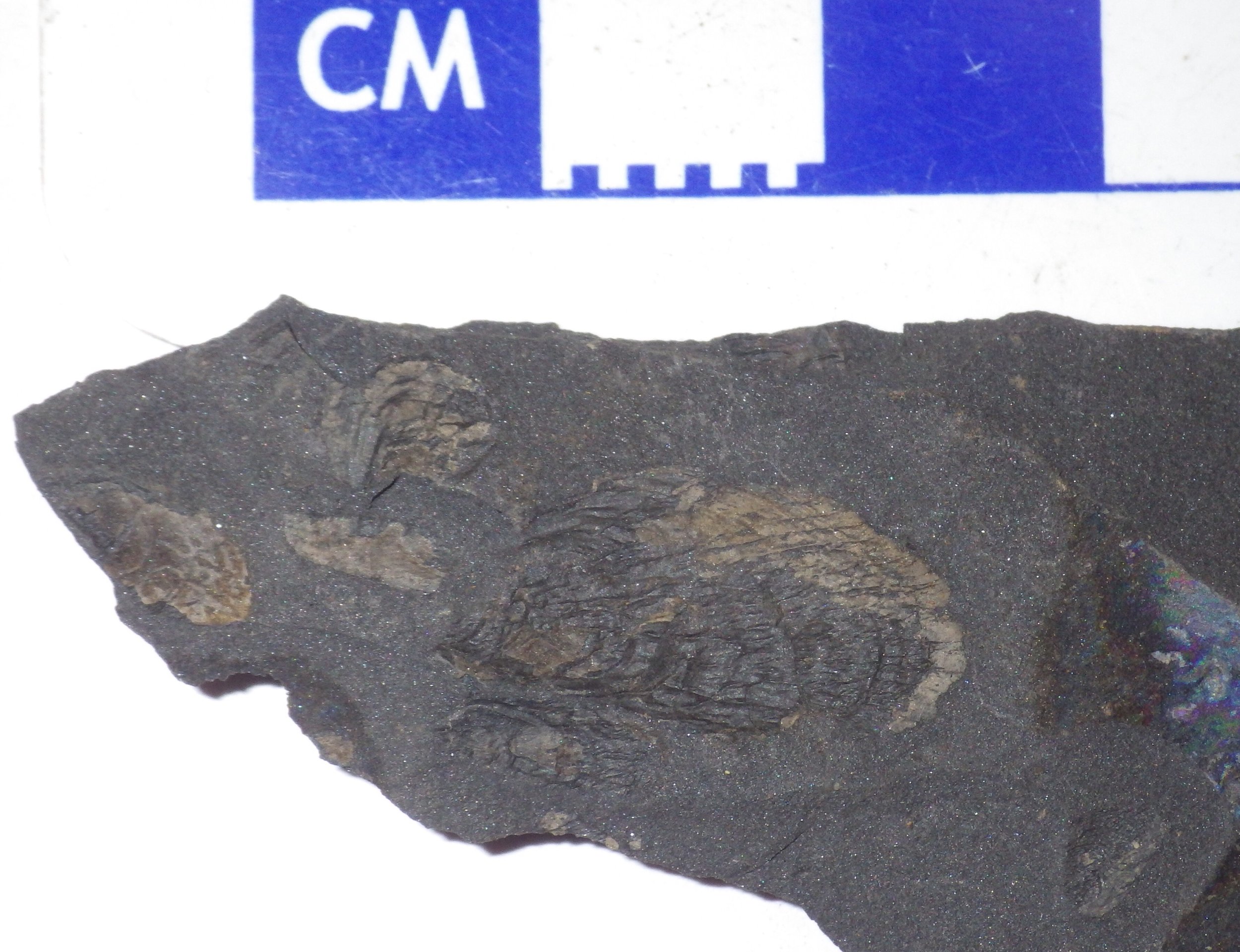 As Brett, Tim, and I headed back to Virginia after our fossil plant collecting trip to Beckley, West Virginia a couple of weeks ago, we made a second brief collecting stop in Princeton, WV. Several years ago, Tim and I stumbled onto a fossiliferous outcrop while fixing a flat tire of my field truck, so we revisited this site to collect some specimens for WSC.The outcrop exposes the Late Carboniferous Pride Shale Member of the Bluestone Formation, which seems to represent a shallow intertidal environment. It looks like all the fossils we collected are tiny pteroid mollusks, most of which are less than 2 mm long. We collected a few small pieces of shale (the outcrop is weathered, and the shale tends to fall apart), which contains perhaps 50-100 mollusk specimens. There is also a possibility that fossils of other organisms could turn up once we've had a chance to examine the rocks more carefully.
As Brett, Tim, and I headed back to Virginia after our fossil plant collecting trip to Beckley, West Virginia a couple of weeks ago, we made a second brief collecting stop in Princeton, WV. Several years ago, Tim and I stumbled onto a fossiliferous outcrop while fixing a flat tire of my field truck, so we revisited this site to collect some specimens for WSC.The outcrop exposes the Late Carboniferous Pride Shale Member of the Bluestone Formation, which seems to represent a shallow intertidal environment. It looks like all the fossils we collected are tiny pteroid mollusks, most of which are less than 2 mm long. We collected a few small pieces of shale (the outcrop is weathered, and the shale tends to fall apart), which contains perhaps 50-100 mollusk specimens. There is also a possibility that fossils of other organisms could turn up once we've had a chance to examine the rocks more carefully.
Fossil Friday - nautiloid cephalopod
 Because I'm still at the SE GSA conference today's Fossil Friday post will have to be a short one. Last week Brett and I were in Chicago for the NSTA conference, after which we started driving to Chattanooga for SE GSA. The drive across the intervening states of Indiana, Ohio, and Kentucky took us through some of richest fossil deposits in the world, the Ordovician rocks of the Cincinnati Arch. Practically every exposure of rocks in this region will include at least some marine invertebrate fossils, so even though it was cold and we were pressed for time we still made a quick stop at a road cut in Kentucky. Ten minutes of searching revealed the fossil shown above, a nice natural cast of a nautiloid shell.Nautiloids are cephalopods, the group of mollusks that includes squid and octopus. While most modern cephalopods don't have an external shell, the nautiloids (including the extant chambered nautilus) have a subdivided calcium carbonate shell. While nautiloids are rare today they were much more common and diverse in the past, and during the Ordovician Period were apex predators. But even though they were more common in the Ordovician than they are today, they weren't that common, and usually make up only a tiny percentage of the fossils in most Ordovician deposits. That makes this a very nice find for a single 10-minute stop.
Because I'm still at the SE GSA conference today's Fossil Friday post will have to be a short one. Last week Brett and I were in Chicago for the NSTA conference, after which we started driving to Chattanooga for SE GSA. The drive across the intervening states of Indiana, Ohio, and Kentucky took us through some of richest fossil deposits in the world, the Ordovician rocks of the Cincinnati Arch. Practically every exposure of rocks in this region will include at least some marine invertebrate fossils, so even though it was cold and we were pressed for time we still made a quick stop at a road cut in Kentucky. Ten minutes of searching revealed the fossil shown above, a nice natural cast of a nautiloid shell.Nautiloids are cephalopods, the group of mollusks that includes squid and octopus. While most modern cephalopods don't have an external shell, the nautiloids (including the extant chambered nautilus) have a subdivided calcium carbonate shell. While nautiloids are rare today they were much more common and diverse in the past, and during the Ordovician Period were apex predators. But even though they were more common in the Ordovician than they are today, they weren't that common, and usually make up only a tiny percentage of the fossils in most Ordovician deposits. That makes this a very nice find for a single 10-minute stop.
Fossil Friday - amber snails
 Worldwide, easily the most common fossils are from marine invertebrates. Most sedimentary rocks are formed in the ocean, invertebrates are present in vast numbers, and the ocean is an excellent place to be buried in the mud, increasing the likelihood of being preserved. In contrast, the fossil collections at the Western Science Center are dominated by terrestrial deposits from Riverside County, so most of our fossils are land vertebrates. We do, however, have a pretty good collection of terrestrial and freshwater invertebrates in the collections.Above is the shell of an amber snail (Gastropoda) from the genus Succinea. Amber snails are air-breathing snails (they have lungs) that generally live in marshy areas. The genus is wide-ranging, and modern Succinea are found all over North America. Below is the same shell in a different orientation, showing the aperture (the opening to the inside of the shell):
Worldwide, easily the most common fossils are from marine invertebrates. Most sedimentary rocks are formed in the ocean, invertebrates are present in vast numbers, and the ocean is an excellent place to be buried in the mud, increasing the likelihood of being preserved. In contrast, the fossil collections at the Western Science Center are dominated by terrestrial deposits from Riverside County, so most of our fossils are land vertebrates. We do, however, have a pretty good collection of terrestrial and freshwater invertebrates in the collections.Above is the shell of an amber snail (Gastropoda) from the genus Succinea. Amber snails are air-breathing snails (they have lungs) that generally live in marshy areas. The genus is wide-ranging, and modern Succinea are found all over North America. Below is the same shell in a different orientation, showing the aperture (the opening to the inside of the shell):
 Succinea is a tiny snail; the black box the shell is sitting on in the images is only 1 cm across! A fairly large number of Succinea shells were recovered in the Pleistocene deposits from Diamond Valley Lake.
Succinea is a tiny snail; the black box the shell is sitting on in the images is only 1 cm across! A fairly large number of Succinea shells were recovered in the Pleistocene deposits from Diamond Valley Lake.
Fossil Friday - Cretaceous invertebrate donation
 Last Wednesday, Hemet resident Jeanette Hughes visited the Western Science Center to donate a box of Cretaceous invertebrate fossils that she and her late husband Richard collected more than a decade ago in Texas.Most of the specimens in the donation were ammonites, extinct cephalopods related to the modern chambered nautilus:
Last Wednesday, Hemet resident Jeanette Hughes visited the Western Science Center to donate a box of Cretaceous invertebrate fossils that she and her late husband Richard collected more than a decade ago in Texas.Most of the specimens in the donation were ammonites, extinct cephalopods related to the modern chambered nautilus:
 There were also several sea biscuits, a type of echinoid related to sand dollars:
There were also several sea biscuits, a type of echinoid related to sand dollars:
 A number of species of bivalve mollusks were represented, including oysters from the genus Gryphaea (or a close relative):
A number of species of bivalve mollusks were represented, including oysters from the genus Gryphaea (or a close relative):
 One of the oysters is impressively large (note the 10 cm scale bar):
One of the oysters is impressively large (note the 10 cm scale bar):
 Jeanette was able to provide us with pretty precise locality information for these specimens, making them potentially much more useful from a scientific standpoint. WSC did not have much of material from these taxa or from this time period, so this is a nice addition to our collection. I'd like to thank Jeanette for her kind donation.
Jeanette was able to provide us with pretty precise locality information for these specimens, making them potentially much more useful from a scientific standpoint. WSC did not have much of material from these taxa or from this time period, so this is a nice addition to our collection. I'd like to thank Jeanette for her kind donation.











